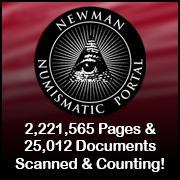
About UsThe Numismatic Bibliomania Society is a non-profit association devoted to the study and enjoyment of numismatic literature. For more information please see our web site at coinbooks.org SubscriptionsThose wishing to become new E-Sylum subscribers (or wishing to Unsubscribe) can go to the following web page link MembershipThere is a membership application available on the web site Membership Application To join, print the application and return it with your check to the address printed on the application. Print/Digital membership is $40 to addresses in the U.S., and $60 elsewhere. A digital-only membership is available for $25. For those without web access, write to: Terry White, Treasurer AsylumFor Asylum mailing address changes and other membership questions, contact Terry at this email address: terrywhite5475@yahoo.com SubmissionsTo submit items for publication in The E-Sylum, write to the Editor at this address: whomren@gmail.com BUY THE BOOK BEFORE THE COINSale Calendar |
- WAYNE'S WORDS: THE E-SYLUM OCTOBER 10, 2018
- MORE ON NBS FOUNDING MEMBERS
- LONDON MINT OF CONSTANTIUS AND CONSTANTINE SUPPLEMENT
- CHARLES FARRELL LONG SR. (1933-2018)
- HERITAGE AUCTIONS PREDECESSOR FIRMS ON NNP
- NEWMAN NUMISMATIC PORTAL USER SURVEY
- ANCIENT COIN CLASSIFICATION BY COMPUTER
- NOTES FROM E-SYLUM READERS: OCTOBER 7, 2018
- FANTASY JERSEY FIVE REICHMARK TOKEN
- QUERY: ADMIRAL BYRD DIE SHELL INFORMATION SOUGHT
- FLORIDA PAPER COLLECTORS LUNCH GROUP
- DON CORRADO ROMANO (1903-1984)
- ARTICLE PROFILES MARY ELLEN WITHROW
- INTERVIEW: MONEY ARTIST MARK WAGNER
- ANA EXHIBITS 1943 BRONZE CENT
- ANA WWI IN REMEMBRANCE VIRTUAL EXHIBIT
- WILLIAM AND CHARLES BARBER EXHIBIT AT WHITMAN EXPO
- MUSEUM RECEIVES TEXIAN NAVY SCRIP
- EXHIBIT EXPLORES ELECTRONIC MONEY
- JOHN MAX WULFING COLLECTION CATALOGUER SOUGHT
- OCTOBER 2018 MEDAL SELECTIONS FROM NUMISMAGRAM
- MICHAEL GIETZELT COLLECTION OF MILLED COINS
- STACK'S BOWERS OCTOBER 2018 SALES SELECTIONS PART 1
- NUMISMATIC NUGGETS: OCTOBER 7, 2018
- COLONIAL AMERICAN LOTTERY TICKETS
- 19TH CENTURY EXPOSITION MEDAL COLLECTION
- PRESIDENT TRUMP AWARDS MEDAL OF HONOR
- 1976 QUEEN ELIZABETH II US BICENTENNIAL MEDALS
- THE CASE OF THE SHERLOCKIAN CHOCOLATE COINS
- COIN MADE WITH WORLD'S OLDEST SCOTCH
- PRE-CONQUEST COINS OF WESTEROS
- LOOSE CHANGE: OCTOBER 7, 2018
Click here to access the complete archive
To comment or submit articles, reply to whomren@gmail.com
Content presented in The E-Sylum is not necessarily researched or independently fact-checked, and views expressed do not necessarily represent those of the Numismatic Bibliomania Society.
WAYNE'S WORDS: THE E-SYLUM OCTOBER 10, 2018
 This week we open with some of our founding
members, one new book supplement, the passing of an Assay Commission member, and updates from the Newman Numismatic Portal.
This week we open with some of our founding
members, one new book supplement, the passing of an Assay Commission member, and updates from the Newman Numismatic Portal.
Other topics this week include Steve Ivy Auctions, Florida Paper Money collectors, dealer Don Corrado Romano, U.S. Treasurer Mary Ellen Withrow, money artist Mark Wagner, the 1943 bronze cent, and the Texian Navy warrants.
To learn more about ancient coin classification by computer, the John Max Wulfing Collection, Testoons and Shillings, fantasy Channel Islands tokens, electronic money, the Hague Peace Conference Medal, mythical brewing abilities, The Great Denver Mint Robbery of 1922, the 1783 Treaty of Paris Medal and a coin made with scotch, read on. Have a great week, everyone!
Wayne Homren
Editor, The E-Sylum
MORE ON NBS FOUNDING MEMBERS
Last week Pete Smith asked about the founding members of our organization. Alan Luedeking compiled a list from early issues of our print journal, The Asylum. -Editor
Perusing The Asylum, Vol. 1 No. 1 (Summer 1980) and subsequent issues, along with Joel Orosz's article "The Numismatic Bibliomania Society, 1980-1997 - A History of Seventeen Years in Fifteen Volumes" published in 1998 (I think), I conclude the following members were among the "dozen or so" founders (but none except the first two are an absolute certainty):
- George Frederick Kolbe (first and only officer of the society)
- Jack Collins
- John Adams (not our 2nd president!)
- John J. Ford
- Armand Champa
- A certain "GL" who abstained from joining the group because he was offended by the name
- Randolph Zander
- Richard Picker
- Richard Lane
- J. Richard Becker
- Howard S. Baron
- David Edmunds
- Herman Miller
- John R. Mawhinney
Pete's primary question was about a dinner held during the 1979 ANA convention in St. Louis: "It was reported that about a dozen people attended. I have not found a published list of their names." George Kolbe and John W. Adams are still with us. Collins, Zander and Picker are gone, but I don't know about the others. If you're among that group or know someone who is, please pass along any recollections of the dinner. Thanks. -Editor
To read the earlier E-Sylum article, see:
LIST OF NBS FOUNDING MEMBERS SOUGHT (http://www.coinbooks.org/v21/esylum_v21n39a02.html)
LONDON MINT OF CONSTANTIUS AND CONSTANTINE SUPPLEMENT
Hugh Cloke & Lee Toone report that they have published a supplement for their book on the London Mint of Constantius and Constantine. Thanks. -Editor
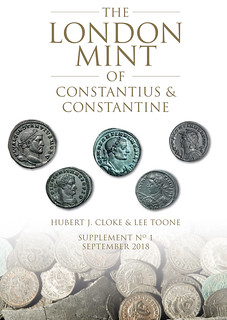 We have just
published on Lee’s HOOKMOOR web site a downloadable pdf supplement to our 2015 book, The London Mint of Constantius and Constantine (LMCC). The supplement is designed so
that users of LMCC can add it to their copies of the book for easy reference. The document, “Supplement No. 1”, follows the A4 format of the book. It includes a number of blank
pages to allow for home printing into a booklet of 28 pages when print both sides is selected.
We have just
published on Lee’s HOOKMOOR web site a downloadable pdf supplement to our 2015 book, The London Mint of Constantius and Constantine (LMCC). The supplement is designed so
that users of LMCC can add it to their copies of the book for easy reference. The document, “Supplement No. 1”, follows the A4 format of the book. It includes a number of blank
pages to allow for home printing into a booklet of 28 pages when print both sides is selected.
The supplement records and illustrates coin types reported since 2015 as well illustrating several types recorded but not illustrated in LMCC.
Additions to LMCC currently listed on the HOOKMOOR website and included in this supplement will be removed from the website. The ‘Corrections’ webpage, however, is still current and will continue to be updated to reflect necessary corrections following the publication of this supplement.
We expect that the current “Supplement” will be the first of a series of periodic updates to LMCC. We continue to welcome submissions of newly discovered types and variants to
be published on the HOOKMOOR site or in future supplements. The supplement can be found at -
http://www.hookmoor.com/home/?page_id=690 We wish to thank all of those who contributed to the success of the book and the
construction of the supplement.
To read the earlier E-Sylum article, see:
NEW BOOK: LONDON MINT OF CONSTANTIUS AND CONSTANTINE (http://www.coinbooks.org/esylum_v18n36a06.html)
CHARLES FARRELL LONG SR. (1933-2018)
Former Assay Commissioner Charlie Farrell has died. Here's an excerpt from his obituary. -Editor
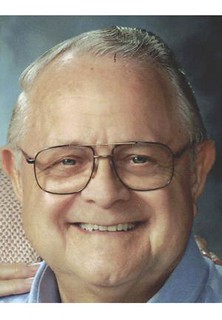 Charles Farrell Long Sr., 84, passed
away on September 30, 2018, at a local hospital with his family by his side, after having had a massive stroke on September 22, 2018. He was born on November 19, 1933, at 901 High
Street in Charlottesville, to Cecil Early Long and Ruth Elizabeth (Shifflett) Long.
Charles Farrell Long Sr., 84, passed
away on September 30, 2018, at a local hospital with his family by his side, after having had a massive stroke on September 22, 2018. He was born on November 19, 1933, at 901 High
Street in Charlottesville, to Cecil Early Long and Ruth Elizabeth (Shifflett) Long.
He served in the United States Navy from January 6, 1954 to November 1, 1957. Upon leaving the Navy, he and Ann started Group Underwriters Insurance Agency in 1969 with the goal of providing a "family feel" to insurance. Through Charlie's hard work, Group Underwriters has grown to insure clients in over 30 states. Charlie was a workaholic and was happiest serving his clients or being at home out working in the yard. He enjoyed helping the Charlottesville community whenever he could be of service.
He worked on the local Bicentennial Committee, where he was instrumental in having the Queen's Medal designed and produced through working with the then current Chief Engraver of the U.S., the Secretary of State, and the Secretary of the Treasury. He participated in the presentation of the medal to and met Queen Elizabeth II.
As a result of his tireless work on this project, he was appointed by President Ford to serve on the Assay Commission. All these things and few people ever knew. He did not brag about his accomplishments. He traveled the country but was always happiest when he came home to Charlottesville where he was a lifetime resident.
Curious about the Bicentennial medal, I poked around for information and compiled and article appearing elsewhere in this issue. Did any of our readers know him? Was he a coin collector? -Editor
To read the complete article, see:
Long Sr., Charles Farrell
(https://www.dailyprogress.com/obituaries/long-sr-charles-farrell/article_2c0100f6-f738-553c-9cdd-6a0eff1c3bd3.html)

HERITAGE AUCTIONS PREDECESSOR FIRMS ON NNP
The latest additions to the Newman Numismatic Portal are the auction catalogs of Steve Ivy and New England Rare Coin Auctions. Project Coordinator Len Augsburger provided the following report. -Editor
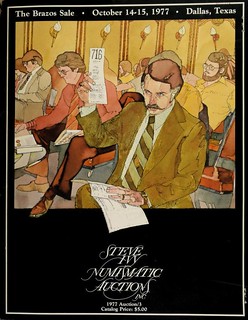 Newman Portal has recently added
the auction sale catalogs of the Heritage Auctions predecessor firms, New England Rare Coin Auctions and Steve Ivy Numismatic Auctions. Martin Gengerke’s American Numismatic
Auctions lists 29 sales for New England between 1975 and 1982, and 53 for Steve Ivy between 1972 and 1983.
Newman Portal has recently added
the auction sale catalogs of the Heritage Auctions predecessor firms, New England Rare Coin Auctions and Steve Ivy Numismatic Auctions. Martin Gengerke’s American Numismatic
Auctions lists 29 sales for New England between 1975 and 1982, and 53 for Steve Ivy between 1972 and 1983.
The earlier New England catalogs evoke the classic Stack’s catalog layout, and include numerous closeups demonstrating variety features, a distinctive feature at this time. Later catalogs begin to feature color plates that are still useful for pedigree purposes.
The Steve Ivy catalogs are virtually identical to the (later) Heritage catalogs and clearly were prepared by the same team. These include color plates from the beginning (1976), not an inexpensive proposition at the time, and the very first catalog notes the use of “full color transparencies and four color printing.” Newman Portal acknowledges Jim Halperin and Steve Ivy for extending permission to scan these sale catalogs.
Link to New England Rare Coin Auctions:
https://nnp.wustl.edu/library/auctioncompanydetail/511382
Link to Steve Ivy Numismatic Auctions:
https://nnp.wustl.edu/library/auctioncompanydetail/511017
NEWMAN NUMISMATIC PORTAL USER SURVEY
Newman Numismatic Portal Project Coordinator Len Augsburger writes:
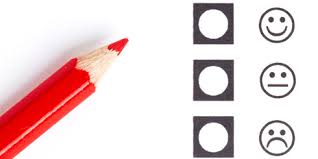 Newman Portal invites responses to its first
user survey. This survey consists of a few multiple choice questions and allows freeform comment input at the conclusion. Survey results will help guide the future direction of
the Newman Portal. Feel free to comment on the good, the bad, and the ugly – all input will be carefully considered.
Newman Portal invites responses to its first
user survey. This survey consists of a few multiple choice questions and allows freeform comment input at the conclusion. Survey results will help guide the future direction of
the Newman Portal. Feel free to comment on the good, the bad, and the ugly – all input will be carefully considered.
Link to Newman Portal User Survey:
https://www.surveymonkey.com/r/9R6ZMX6
ANCIENT COIN CLASSIFICATION BY COMPUTER
Robot coin cataloguer? How about a computer program that classifies ancient coin images by looking at them? Here's an excerpt from a new paper by a group of researchers in Italy and Turkey. -Editor
Abstract
Recognizing the type of an ancient coin requires theoretical expertise and years of experience in the field of numismatics. Our goal in this work is automatizing this
time-consuming and demanding task by a visual classification framework.
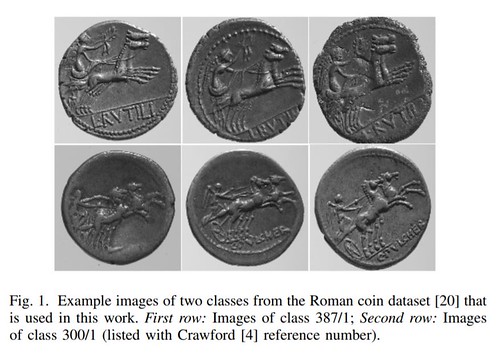
Specifically, we propose to model ancient coin image classification using Graph Transduction Games (GTG). GTG casts the classification problem as a non-cooperative game where the players (the coin images) decide their strategies (class labels) according to the choices made by the others, which results with a global consensus at the final labeling. Experiments are conducted on the only publicly available dataset which is composed of 180 images of 60 types of Roman coins. We demonstrate that our approach outperforms the literature work on the same dataset with the classification accuracy of 73.6% and 87.3% when there are one and two images per class in the training set, respectively.
Ancient coins, that depict cultural, political and military events, natural phenomena, ideologies and portraits of god and emperors are important source of information for historians and archaeologists. Recognizing the type of an ancient coin requires theoretical expertise and years of experience in the field of numismatics. A common way to detect the period of a discovered coin is searching through the manual books where ancient coins are indexed which requires a highly time consuming labor.
Our goal in this paper is automatizing recognition of Roman coins by employing computer vision and pattern recognition techniques. Automatizing such a manual procedure not only provides faster processing time but also can support historians and archaeologists for a more accurate decision. A visual classification framework for ancient coin recognition can also be used at museums or by individual collectors to organize large collections of coins.
From the computer vision point of view, classification of ancient coin images is a highly challenging task. One of the difficulties arises from existence of high number of types (i.e. classes) in ancient coins (e.g. Portuguese coins from medieval period and coins from Roman Republic compose over 1500 and 550 different classes, respectively), while most of the classes include few known specimens as mentioned... Moreover, intra-class variation is large due to local spatial variations arising from missing parts and degradations on the coins, and manual manufacturing of coins by different engravers. Another reason of large intra-class variation is the metallic structure of these coins yields to strong reflection and shading variations so the appearance of the same coin changes significantly under different lighting conditions.
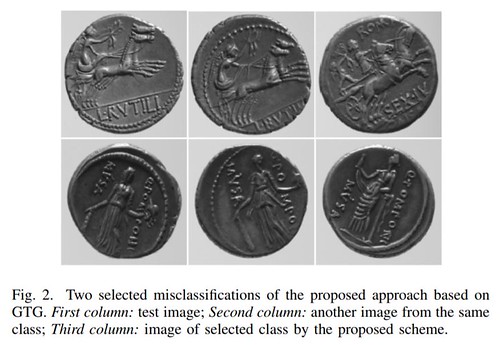
Yep - it's a hard problem, maybe impossibly so. Yet these techniques show promise, and with a large, high-quality, well-annotated image set, perhaps this could become a routine task for computers someday. This project used a very small dataset of just 180 images. -Editor
To read the complete article, see:
Ancient Coin Classification Using Graph Transduction Games (https://arxiv.org/pdf/1810.01091.pdf)
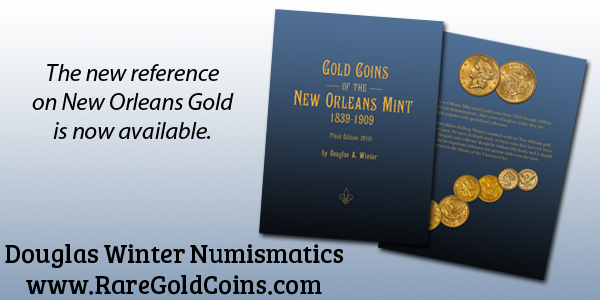
NOTES FROM E-SYLUM READERS: OCTOBER 7, 2018
Update to Bowers Continental Dollar Article
Regarding last week's Dave Bowers article on the Continental Dollar, Maureen Levine writes:
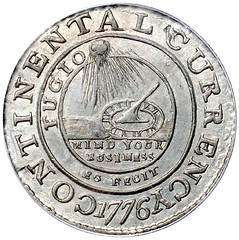 Neither Eric P. Newman nor I ever stated that the Continental Dollars were bought and sold in England, or that
they were created as medals. In our July 2014 article in The Numismatist, "18th-Century Writings on the Continental Currency Dollar Coin," we wrote that the
earliest print mention and illustration of the coin was in a 1783 German almanac featuring a chronicle of the American Revolution written by prominent historian M.C. Sprengel.
Nowhere did we suggest anything but an American origin.
Neither Eric P. Newman nor I ever stated that the Continental Dollars were bought and sold in England, or that
they were created as medals. In our July 2014 article in The Numismatist, "18th-Century Writings on the Continental Currency Dollar Coin," we wrote that the
earliest print mention and illustration of the coin was in a 1783 German almanac featuring a chronicle of the American Revolution written by prominent historian M.C. Sprengel.
Nowhere did we suggest anything but an American origin.
Dave has since updated his article, and we have done the same with the version of the E-Sylum archived on the NBS web site.
Perhaps someday some contemporary documentation will be found to settle once and for all the uncertainty around the origin of these pieces. While it's heartening to see many people open to new evidence and thinking, I don't see a solid verdict on these yet one way or another. The British origin theory is gaining traction, but I'm not sure the American origin theory can be completely ruled out either. As we noted at the beginning of this discussion some months back, all we have is a lack of evidence. -Editor
To read the updated E-Sylum article, see:
1776 CONTINENTAL ITEM: FROM COIN TO MEDAL (http://www.coinbooks.org/v21/esylum_v21n39a16.html)
To read the updated Mint News Blog article, see:
From coin to medal: Transition of the 1776 Continental Currency coin
(http://mintnewsblog.com/from-coin-to-medal-transition-of-the-1776-continental-currency-coin/)
Cheyenne Agency Token
Regrding an article published last week, Larry Dziubek writes:
You have a photo error in the Feisel section. You have two “paradise” items and no Cheyenne Agency token.
Oops - Larry's right. One of the images was duplicated. Here it is. We'd also updated the version archived on the NBS web site. Thanks. -Editor
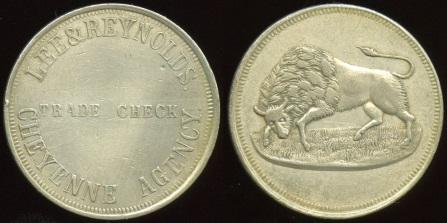
To read the earlier E-Sylum article, see:
FEISEL TOKEN SALE CLOSES OCTOBER 27, 2018 (http://www.coinbooks.org/v21/esylum_v21n39a22.html)
Clapp's French Sale Catalog
Jan Valentine writes:
Thanks to George Kolbe's help we now know there are at least nine leatherbound French catalogs around. Can anyone who has seen George Clapp's copy, I think it's at the Carnegie Library of Pittsburgh, share with the readers whether his was also in leather and whether his name was stamped on the front cover? I know B. Max Mehl and Clapp were not close !
I've seen the copy in the Wadsworth Rare Book Room at Carnegie Library, but I'm afraid I don't remember if it was a deluxe copy. I was still pretty new to numismatic literature and not familiar with the variants. And there were no cell phones in those days to capture photos. Can anyone help on this one? -Editor
To read the earlier E-Sylum article, see:
NOTES FROM E-SYLUM READERS: SEPTEMBER 30, 2018 : More on Leatherbound French Catalogs
(http://www.coinbooks.org/v21/esylum_v21n39a09.html)
Plaster Casts in Coin Photography
The article last week by Jeff Garrett on photography in numismatics described a photograph of an 1804 Silver Dollar which was "actually a photo of a plaster cast; the actual coins were deemed too shiny to photograph". -Editor
Kavan Ratnatunga writes:
Do you have a range in years that the plaster cast method was used?
I found same in the Ceylon Coins and Currency book published in 1924:
http://coins.lakdiva.org/museum_cc/cnm_ccc55.html .
Jan Lingen gave some possible reasons on that page but not that the coins would have been to shiny.
Is that because the film sensitivity was low and the object had to be highly illuminated to photograph? However, since a coin is nearly flat couldn't a wider aperture and longer exposure could be used if that was the case? I am trying to understand all the reasons for the use of a plaster cast method.
I haven't studied photography in numismatic literature. Can anyone help answer Kavan's questions? During what period were plaster casts primarily used? Thank you. -Editor
Testoons and Shillings
Regarding the statement in last week's piece from Allan Davisson that "Shillings were a Tudor innovation that began with the coinage reform under Edward VI," David
Powell writes:
No! Previously known as testoons, but of a similar twelve pence value, they originated c.1504 under Henry VII. However, I expect that quite a lot of your English correspondents will be telling you similarly.
Thank you. Here is a short history from the Royal Mint Museum web site. -Editor
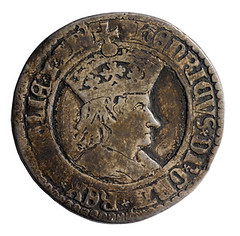
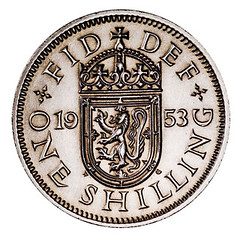
Left: Henry VII testoon; Right: Elizabeth II shilling, 1953
The shilling as a coin was introduced at the beginning of the 16th century during the last years of the reign of Henry VII and until the middle of that century was known as a testoon. It was one of the first English coins to bear a real portrait of the monarch instead of the representative portrait which had served for the previous ten centuries; and it was for this reason that it derived its name of testoon from the Italian Testone or Headpiece introduced in Milan in 1474.
Convenient in size and value, the shilling became one of the popular workhorses of the silver circulation. Colloquially described for some unknown reason as a bob, it was not superseded until 1968, during the preparations for decimalisation,
To read the complete article, see:
Shilling
(http://www.royalmintmuseum.org.uk/coins/british-coinage/old-denominations/shilling/index.html)
To read the earlier E-Sylum article, see:
THE SHILLINGS OF ELIZABETH I (http://www.coinbooks.org/v21/esylum_v21n39a24.html)
1978 Zodiac Calendar Medal Designer
 Last week I asked about
the designer of the 1978 Zodiac Calendar Medal. Rich Jewell writes:
Last week I asked about
the designer of the 1978 Zodiac Calendar Medal. Rich Jewell writes:
Marcel Jovine is the artist in question
Correct -Editor
To read the earlier E-Sylum article, see:
NUMISMATIC NUGGETS: SEPTEMBER 30, 2018 : 1978 Zodiac Calendar Medal
(http://www.coinbooks.org/v21/esylum_v21n39a20.html)
What Is That Thing?
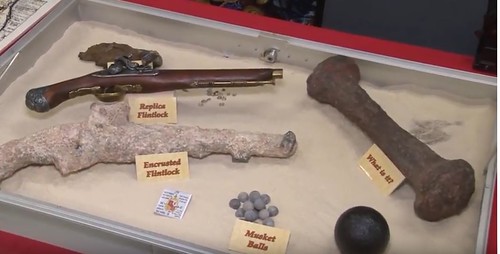
Gary Beals writes:
Well now I am curious (even though it is not numismatics) — The bar-bell shaped piece in the display case at Ben Costello's 1715 Fleet Treasure Coins display is marked with “What is it?” unlike all the other pieces which are identified. I can’t tell if the display is going after audience involvement or the exhibitor does not know that that piece is.
I believe that is an invention cannoneers created centuries ago hoping to tear away a sailing ship’s rigging and canvas. It was supposed to whirl through the air and rip away a vessel’s ability to sail properly. But in reality the pieces just flew straight and punched out a round hole in the sail rather than ripping great gashes in the material aloft. That’s my memory from somewhere — and after all, I was in the U.S. Air Force not the Navy.
Correct! The sign encourages people to ask, and that is indeed the answer. The intent at least, was to blast these at the enemy ship's rigging. -Editor
To read the earlier E-Sylum article, see:
PAN FALL 2018 SHOW VIDEOS PUBLISHED (http://www.coinbooks.org/v21/esylum_v21n39a08.html)
Confederate Numismatica Supplement One Correction
Author Peter Bertram submitted this correction to his Confederate Numismatica Supplement One. Thanks. -Editor
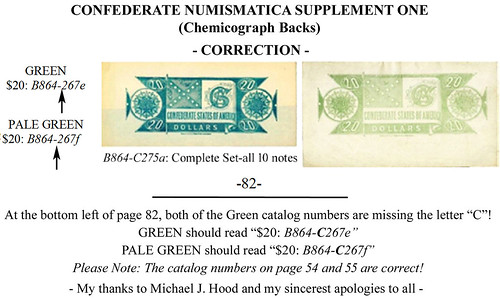
For more information on his book, see these earlier E-Sylum articles:
NEW BOOK: CONFEDERATE NUMISMATICA SUPPLEMENT ONE (http://www.coinbooks.org/v21/esylum_v21n32a05.html)
REVIEW: CONFEDERATE NUMISMATICA SUPPLEMENT ONE (http://www.coinbooks.org/v21/esylum_v21n35a05.html)
FANTASY JERSEY FIVE REICHMARK TOKEN
Regarding the odd token I asked about last week, Paul Bosco writes:
 This is one of a series of
fantasies of Channel Islands tokens. There are very roughly a dozen different. They appeared in the late 1960s at the earliest. The Channel Islands were indeed occupied by Nazi
Germany, but I am not aware of any metallic numismatica. The notion that Germany would issue high-denomination tokens, regulating daily life under the dreary prevailing
conditions, is ridiculous.
This is one of a series of
fantasies of Channel Islands tokens. There are very roughly a dozen different. They appeared in the late 1960s at the earliest. The Channel Islands were indeed occupied by Nazi
Germany, but I am not aware of any metallic numismatica. The notion that Germany would issue high-denomination tokens, regulating daily life under the dreary prevailing
conditions, is ridiculous.
I think there may be an article in the Numismatics International Bulletin from the 1970s, cataloging the series. I don't think Schwan-Boling's book, World War II Remembered includes them.
They are now about a half-century old, and may be worth $10-15, as fantasies, silly as they are.
Thanks. I wasn't even aware that Germany had occupied the islands. Even so, that did sound like a very high denomination for a token. Thanks for the background.
I checked the Newman Numismatic Portal using a number of search term variations and even the Advanced Search feature to look just in the NI Bulletin, but was unable to locate the article Paul mentioned. But an internet search did turn up the following page on a War Relics site. -Editor

For the last 42 years I have collected WW.2 German militaria, and in the last 25 years have specialised in items that can be proven to have a direct link with the Channel Islands. I like soldbuch, wehrpass, photo albums, permits and I/D cards both military and civilian. Occasionally you will find items like helmets with a name, rank and FP number...to me that is like the holy grail. As you would expect over the years other collectors and dealers who I know have contacted me to say they have picked up and seen items that might be what I am after which is fantastic that they have taken the time to bother. On some occasions I have been offered what are known as "Jersey tokens", unfortunately I then have to let the people know that what they have are in fact FANTASY items made in the USA in the late 60's early 70's.
These tokens are not even based on real items..... no such tokens were ever used in any of the Islands during the Occupation, and in all my years of collecting I have never been to a private call locally and been shown any of these tokens as items left over and saved from the Occupation years. I have spoken with a number of collectors who just don't believe me and they reckon I am trying it on. I even had a major US dealer collector insist that the example he had was 100% original as he picked it up years ago at a gun show..... in the USA, so it had to be real.
Well the reason for this post is to let you all know that they are totally fantasy without any shadow of a doubt. So if your offered them, unless you do want them as a curio then stay well away from them. I have seen them for sale at upto £35 each, and they turn up quite often on Ebay..... the sellers you have guessed it, in the USA. Years ago when I was a kid they even used to advertise them as sets for sale in the Exchange and Mart.
All the best from Jersey,
D.
To read the complete article, see:
Channel Island fantasy tokens
(http://www.warrelics.eu/forum/orders-decorations-third-reich/channel-island-fantasy-tokens-327874/)
To read the earlier E-Sylum article, see:
NUMISMATIC NUGGETS: SEPTEMBER 30, 2018 : Jersey Five Reichmark Token
(http://www.coinbooks.org/v21/esylum_v21n39a20.html)
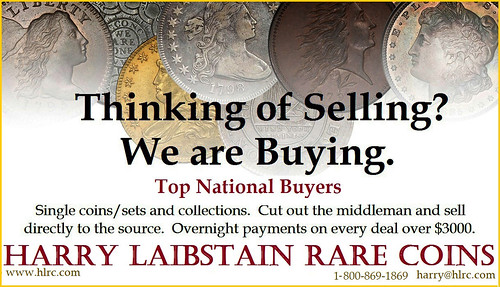
QUERY: ADMIRAL BYRD DIE SHELL INFORMATION SOUGHT
Mike Sanders has an interesting Depression-era item. Can anyone provide more information on it? Thanks. -Editor
 I wonder if any of the readers have
information about this capped cent. A die struck shell covers the obverse and edge of a 1934 Cent leaving the coin's obverse exposed. A bust of Admiral Byrd is pictured with
the date 1935. the coin is contained within a cardboard holder which I am certain is original to the piece.
I wonder if any of the readers have
information about this capped cent. A die struck shell covers the obverse and edge of a 1934 Cent leaving the coin's obverse exposed. A bust of Admiral Byrd is pictured with
the date 1935. the coin is contained within a cardboard holder which I am certain is original to the piece.
Alpert & Elman have included this piece in their Token & Medal book along with others that picture the Morro Castle disaster and the Bruno Haupmann trial, All three of these events occurred within a short period of time. Is anyone aware of other front page news that might have been commemorated in this fashion?
I'm curious to know who produced these and how they were distributed. I do not regularly encounter any of these designs. Any guesses as to their scarcity?
Interesting item. Can anyone tell us more about it? -Editor
FLORIDA PAPER COLLECTORS LUNCH GROUP
Howard A. Daniel III submitted these notes on his recent visit with the Florida Paper Collectors Lunch Group. Thanks. -Editor
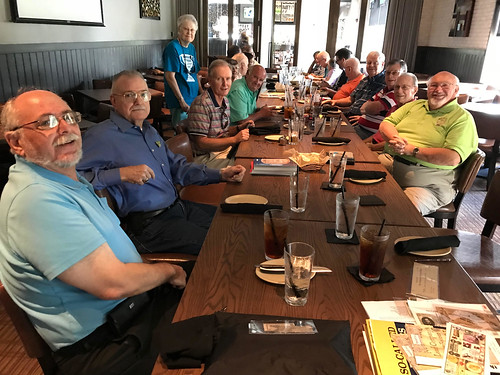
Several members of the Florida Paper Collectors Lunch Group told me about this group at the last Summer FUN Show. Two of these people were John Wilson and Gary Lewis, both past ANA presidents. Nancy Wilson was also there when John and Gary talked to me. The group's primary focus is on fiscal paper from Florida but it also has interests in paper from other states and countries.
The group is guided by Ron Benice of Sarasota, Florida. He can be reached at Benice@Prodigy.net if you want to be put in the queue to attend one of the future lunches. The next lunch meeting is on January 26. Attendance is by invitation only because of the limited space in the lunch room.
Right now, the group meets at Tony Roma's Restaurant at 8560 International Drive, Orlando, FL 32819. The meeting I attended started at about Noon on September 29 with conversation and then lunch. Once the lunch plates were taken away, Ron started the Show & Tell with his paper and then the person next to him started. The meeting ended at about 3PM.
The group included many other numismatists known nationally for their work at ANA and other organizations' events so I was surrounded by many old friends. I am sure every numismatist would have a good time at one of the lunches, but remember it is by invitation only. Good luck.
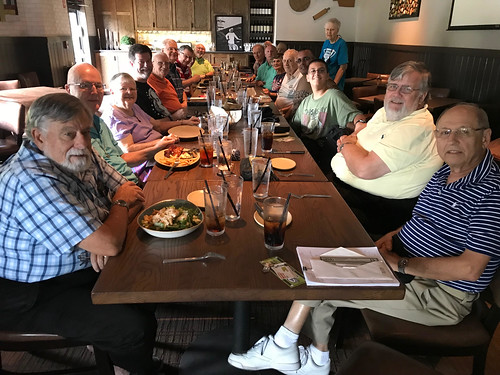
Sounds like a great group, and a fine reason to visit or retire to Florida.
John Wilson provided the photos. In the top one that's Mark Lighterman and Howard Daniel on the left, with Nancy Wilson standing at the back. In the second shot I spy Wendell Wolka sitting second on the right. -Editor
DON CORRADO ROMANO (1903-1984)
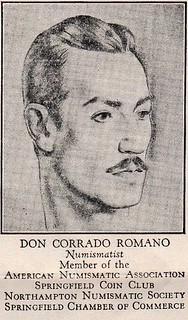 Don Corrado Romano, usually called
"Corrado" was a dealer in coins and stamps in his early years at 25 Harrison Avenue, Springfield, Massachusetts. For some he is known as the owner of a 1776 Continental
Silver Dollar,1792 XF Silver Center Cent, he acquired in 1958, and of the 13 Silver Dollars he owned struck before 1800 is the 1794 B-1, BB-1, XF-40 Silver Dollar, he acquired in
1957, and an 1836 Gobrecht Dollar.
Don Corrado Romano, usually called
"Corrado" was a dealer in coins and stamps in his early years at 25 Harrison Avenue, Springfield, Massachusetts. For some he is known as the owner of a 1776 Continental
Silver Dollar,1792 XF Silver Center Cent, he acquired in 1958, and of the 13 Silver Dollars he owned struck before 1800 is the 1794 B-1, BB-1, XF-40 Silver Dollar, he acquired in
1957, and an 1836 Gobrecht Dollar.
Don Corrado Romano (1903-1984), was born the seventh of eight children on January 21, 1903, in Salerno, Italy, son of Andrea "Andrew" Romano (1863-1960), a bank president, and Raffaella Cerrato Romano (1869-1931), both natives of Salerno, Italy. His family came to America in 1915, when he was an adolescent of twelve. He had already acquired coins from his father who was a banker at an early age. They lived at 29 Locust Street, Springfield, Massachusetts. By 1918, at age 15, like Henry Chapman, Jr., before him, he was already buying and selling coins. However, in later years his ads in Numismatic Scrapbook said : "Dealer Since 1923", i.e., when he was twenty.
In April 1926 he and his brother-in-law Fred Fopiano incorporated F & R Candy Manufacturing Company, 939 Main Street, Springfield, Massachusetts.
From 1927 -1929 Springfield City Directories he and his wife Alice E. V., are listed as living at 935 Main Street. In 1927 he was working as an insurance agent for Boston Mutual Life Insurance Company. In 1929, he is listed as a clerk in his father's bank.
From February to July 1931 he held five coin auctions under the name Romano's Coin Shop.
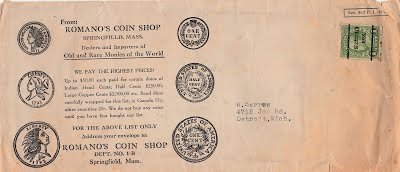
In 1939, he married Mildred K. Grammont (d. 1968), at Hull, Massachusetts. They had a son Don Corrado Romano, Jr. (1926-1999), and a daughter Ella "Penny" Louise Romano (1947-). There is an interesting story surrounding the birth of Ella Romano that was reported by the coin columnist Maurice M. Gould for the Boston Herald in an article "Flying Eagle Cent Lucky," published Sunday, November 29, 1964, on page 260. Gould relates the story of Corrado Romano late in the day about to close his coin and stamp shop when a man walked in wanting to sell him two 1856 Flying Eagle Cents, one for $45 and the second in better condition for $75. Romano, Sr., did not have enough cash on hand to buy both so he opted to buy the better grade for $75. When he got home he discovered his wife Mildred had just been rushed to the hospital to have her baby. When he saw her he told her the story about the coin purchase and they both wanted to call their new daughter "Penny", since she sure brought luck in a good investment. When Ella was married her father gave her and her husband the 1856 Flying Eagle as a wedding present.
Don Corrado Romano, Jr. (1926-1999), was born on February 24, 1926, at Rutherford, New Jersey. Romano, Jr., followed in his father's footsteps and also became a coin dealer.
In 1943, he opened Worthy Coin Company, 23 Cornhill, Boston, Massachusetts, and published and sold coin premium catalogues.
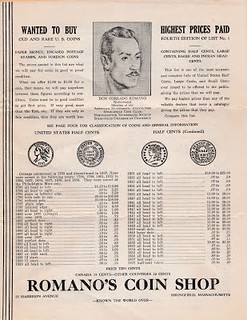
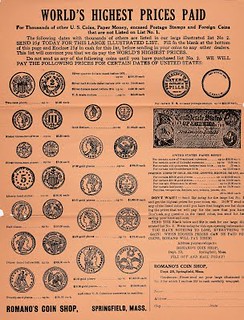
During the 1950s and early 1960s Romano, Sr., hoarded a few hundred or more Proof 1878 trade dollars.
On January 7, 1984, two weeks before his 81st birthday Don Corrado Romano died at Hingham, Massachusetts.
On June 16, 1987, Stack's sold his coin collection comprising 1,625 lots, including : a 1776 Continental Dollar, Lot 24; and a 1792 Silver Center Cent Lot 143;
To read the complete article, see:
ROMANO, DON CORRADO
(https://sites.google.com/a/numismaticmall.com/www/numismaticmall-com/romano-don-corrado)
The entire inventory of the Lupia Numismatic Library is for sale. Individual items will be available before the remaining archives are broken up into parcels sold at philatelic auctions in the U. S. and Hong Kong. Check NumismaticMall.com frequently as dozens of new items with estimates will be posted daily until everything is sold.
All inquiries will be given prompt and courteous attention. Write to: john@numismaticmall.com .
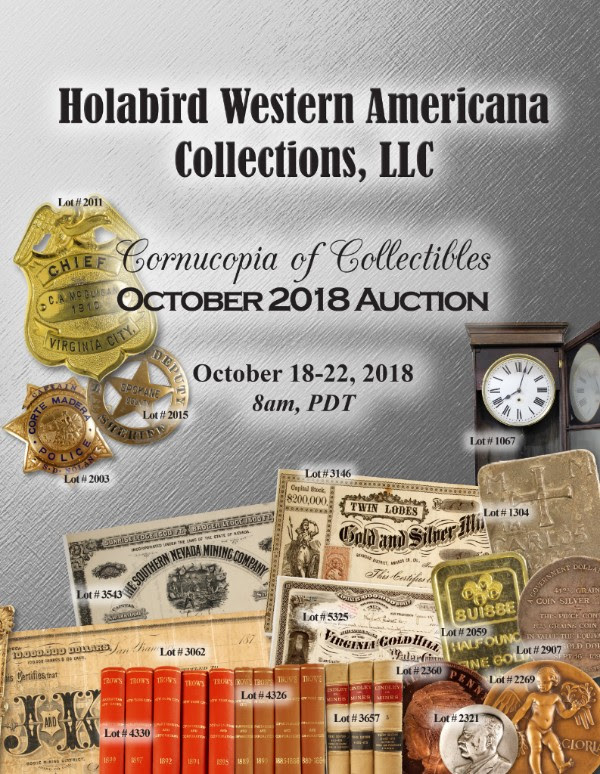
ARTICLE PROFILES MARY ELLEN WITHROW
The Marion Star from Marion, OH has a nice article about Mary Ellen Withrow, the former Treasurer of the United States under President Bill Clinton (from March 1, 1994 to January 20, 2001). -Editor
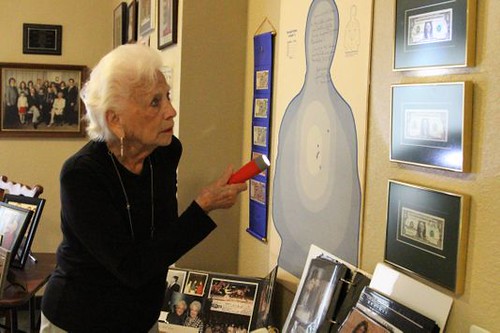
Mary Ellen Withrow at her exhibit
Mary Ellen Withrow walked behind a typically closed door at the Primrose Retirement Community on Thursday. With a flashlight in hand she paused at a plaque bearing her name.
The Harding Graduate had once been awarded the Guinness World Record for having her name on more paper currency than anyone else in the country's history.
"No one has beat my record since," the 87-year-old joked noting that her signature has made it onto more than 68 billion bills.
She said it is part of a collection of items that represent a portal into her life as well as American history.
It serves as a road map of a long political career that took a Marion County woman from a seat on the local school board to the U.S. Treasurer's Office.
Pictures of former presidents, foreign diplomats and political memorabilia hang on the walls of the moderately sized space next to room 105 at Primrose. Tucked behind a glass case is a $20 bill given to John Glenn for good luck as he prepared himself for the journey into space.
"My daughters held onto some of these items for years," Withrow said. "I even forgot that I had some of them."
She usually gives tours herself walking visitors though presidential ornaments, keys to cities, special currency, commemorative coins and medals and other memorabilia from her time in local, state and federal office.
Having retired in 2001, she said the journey that led her to the federal office wasn't an easy one.
When she secured her first victory, the newspaper at the time did not print her name, instead referring to her as Mrs. Norman Withrow.
She would later be appointed U.S. Treasurer by Bill Clinton and unanimously confirmed by the Senate.
In that role, Withrow oversaw the state quarters project, one of her proudest achievements.
She even struck the first state quarters minted.
A Delaware, a Pennsylvania and a New Jersey —the first three quarters in the series— sit in a display case inside the museum.
"I miss it," she said on Thursday. "Everyday I felt so grateful to have the job. I told myself at the time there have only been 39 people that had this before you."
Thanks to the October 2, 2018 issue of the Society of Paper Money's News & Notes for the link.
I met Withrow at least once during her tenure as Treasurer. She was quite approachable when visiting numismatic events.
At one of those events (likely the August 1994 ANA convention) I acquired "The Mary Ellen Withrow I.Q. Test Results" T-shirt picturing a $10 Boggs note. The test of course, was whether anyone would actually confuse it with a genuine note. Withrow played along and signed it, attesting that the Treasurer of the United States, whose signature appears on the bills, understood it was not a dangerous counterfeit subject to confiscation. That she even spoke to "Money Artist" Boggs made her Secret Service handlers crazy. It was the U.S. Secret Service that had raided Boggs' studio and confiscated materials they never returned to him despite not filing charges. -Editor

To read the complete article, see:
Withrow museum to open to public on Saturday
(https://www.marionstar.com/story/news/local/2018/09/28/withrow-museum-open-public-saturday/1454770002/)
INTERVIEW: MONEY ARTIST MARK WAGNER
We've previously discussed Mark Wagner, the artist who uses cut-up U.S. banknotes as his medium. Kai Ryssdal of the public radio show Marketplace interviewed Wager back in April. Not sure why this showed up on my radar only this week, but here it is. -Editor
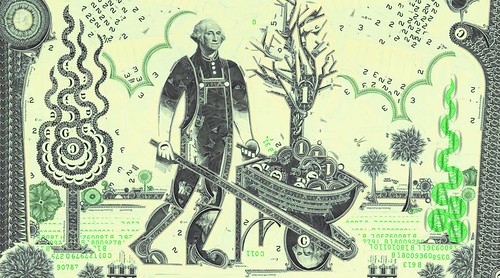
A dollar bill is just a piece of paper. But as everyone knows, money is powerful. New York-based contemporary artist Mark Wagner believes in the emotional power of money. He makes intricate collages with actual U.S. currency. He has used deconstructed dollar bills to make portraits of presidents, recreations of famous paintings and other collages. Marketplace host Kai Ryssdal talked with Mark Wagner about his artwork. The following is and edited transcript of their conversation.
Kai Ryssdal: Why money as a medium for you?
Mark Wagner: I'd been doing collage out of a whole bunch of different materials, and initially, I wanted a piece of paper that was just super common — something that everyone could recognize. There's a power behind taking something that's familiar to everyone and making it into something completely new.
Ryssdal: Yeah. And in some cases, just looking through your catalog, they’re not entirely recognizable. It takes you second sometimes to go, “Oh! That's money.”
Wagner: Yeah. At the shows, I find people pulling dollars out of their wallet a lot and trying to match up pieces with things that they were familiar with.
Ryssdal: And it's all single dollar bills right? You don't you're not into fives and tens and twenties.
Wagner: It's maybe 95 percent single dollar bills at this point. I do mix in fives, some tens and then I use some foreign currency every once in a while. But it's the repetition that I can get from the one, and the fact that the one hasn't been redesigned. If you look at a $1 bill, it's got lots of nice pretty parts on it, leaves and stuff that's been taken out of the fives and the tens.
Ryssdal: The logical question that comes to mind is, boy this must get expensive. I mean, you're cutting up money and using it that way.
Wagner: You know, you would think so, but it's actually cheaper than a lot of other materials. Oil paints are not cheap. You know, a tube of cadmium red for, like, a little 1 ounce tube will put you back like 20 bucks, 30 bucks. And I use almost all of the bill, and there's almost no overlap on the pieces. So, even a big piece, even like a piece the size of a door, might only have, like, $250 on it.
Ryssdal: It's illegal right? Isn't there a law that says you can't destroy American currency?
Wagner: Yes. Yes there is. And everybody brings that up. Any time I see my stuff referred to online, there's always, like, a roll call of nannies and hall monitors complaining about it being illegal. When people ask me that, I like to say, “Should it be illegal?”
Ryssdal: Has the Secret Service come calling yet?
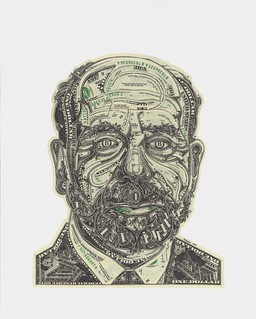 Wagner: No. They haven't. And
actually, I've got some work in the collection of the Federal Reserve.
Wagner: No. They haven't. And
actually, I've got some work in the collection of the Federal Reserve.
Ryssdal: Oh, no come on, seriously? That's, like, too meta.
Wagner: Oh, yeah, they have it. They've got currency collage in their collection. And a couple of years ago there was a portrait of Ben Bernanke that I did that was on display at the National Portrait Gallery in D.C. And I think that's only like two blocks from FBI headquarters.
To read the complete article, see:
This artist cuts up cash and uses it for collage
(https://www.marketplace.org/2017/04/07/life/artist-cuts-cash-and-uses-it-medium)
ANA EXHIBITS 1943 BRONZE CENT
This press release describes a new exhibit at the American Numismatic Association headquarters. -Editor
Other Multi-Million Dollar Rarities on Display
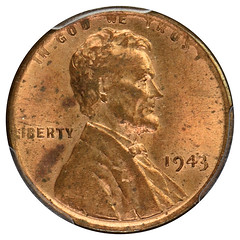 The Edward C. Rochette Money Museum
in Colorado Springs is displaying a bronze cent valued at over $1 million. On loan to the museum, this 1943 Lincoln cent is one of the finest known examples. Bronze cents dated
1943 have been famous since one was first discovered in 1944. While they look like regular-issue cents of any other year, they are incredibly rare.
The Edward C. Rochette Money Museum
in Colorado Springs is displaying a bronze cent valued at over $1 million. On loan to the museum, this 1943 Lincoln cent is one of the finest known examples. Bronze cents dated
1943 have been famous since one was first discovered in 1944. While they look like regular-issue cents of any other year, they are incredibly rare.
These cents are error coins – they were never intended to be struck. All 1943 cents were supposed to be made from zinc-coated steel planchets (discs before they’re struck with the markings of a coin) because copper was needed for World War II. This cent is made of the standard bronze alloy used before 1943 which includes copper, and is one of approximately 15 known examples.
Other numismatic multi-million dollar rarities on display at the Money Museum include two 1913 Liberty Head nickels, the Rittenhouse 1792 half disme and two 1804 silver dollars.
No one is sure how or why the five 1913 Liberty Head nickels were produced. Over the years, they have earned the title of the world’s most valuable coin on several occasions and have consistently been among the price leaders in the numismatic market – one sold during the American Numismatic Association’s World’s Fair of MoneyⓇ in August for $4.5 million.
The 1792 half disme is the first coinage of the United States Mint. Ratification of the Constitution in 1789 gave the federal government the exclusive right to produce coinage and provided for the establishment of the United States Mint. The Money Museum is fortunate to display two examples of this rare and historic coin, including the finest known example that once belonged to David Rittenhouse, first Director of the Mint. The half disme recently sold for $2 million after being on display at the World’s Fair of Money.
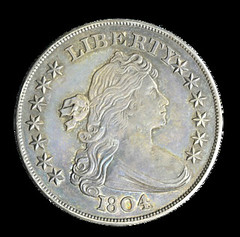 With only 15 known examples, the 1804
silver dollar is recognized among the most coveted of all U.S. rare coins. No dollars dated 1804 were actually struck that year. Only 1803 dated dollars were struck in 1804 at the
United States Mint. 1804 silver dollars routinely sell for over $4 million on the rare occasions they go to auction. The Money Museum has two 1804 dollars on display.
With only 15 known examples, the 1804
silver dollar is recognized among the most coveted of all U.S. rare coins. No dollars dated 1804 were actually struck that year. Only 1803 dated dollars were struck in 1804 at the
United States Mint. 1804 silver dollars routinely sell for over $4 million on the rare occasions they go to auction. The Money Museum has two 1804 dollars on display.
The Money Museum, operated by the nonprofit American Numismatic Association, is located at 818 N. Cascade Ave., adjacent to the campus of Colorado College and next door to the Colorado Springs Fine Arts Center. Museum hours of operation are Tuesday through Saturday, 10:30 a.m. to 5 p.m. Admission is $8 ($6 for seniors, military and students). Kids 12 and under are always free. For more information, call (719) 632-2646 or visit www.money.org/money-museum .
Local Colorado Springs TV station KOAA News visited the exhibit and interviewed the American Numismatic Association's Edward C. Rochette Money Museum Curator/Director Doug Mudd. -Editor
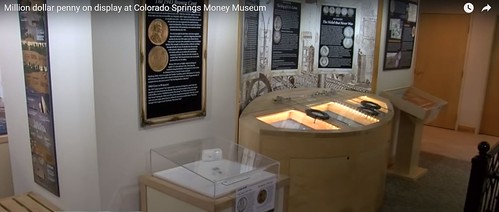
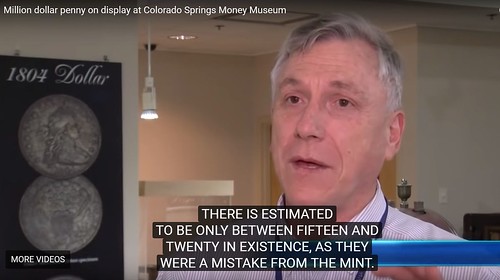
To watch the video, see:
Million dollar penny on display at Colorado Springs
Money Museum (https://koaa.com/news/covering-colorado/2018/10/04/million-dollar-penny-on-display-at-colorado-springs-money-museum/)
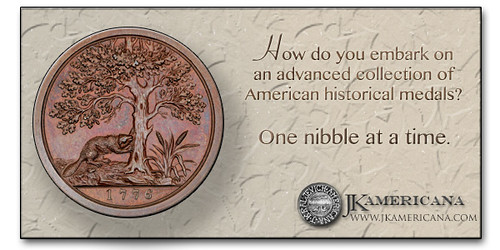
ANA WWI IN REMEMBRANCE VIRTUAL EXHIBIT
The American Numismatic Association's Museum Director/Curator Douglas Mudd has also recently completed a new online exhibit. -Editor
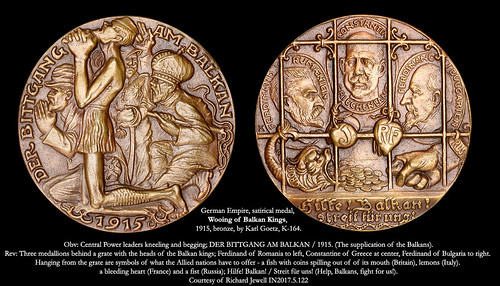
Doug Mudd writes:
The Edward C. Rochette Money Museum continues to expand its virtual presence - we have recently completed the virtual version of our Trenches To Treaties; World War I In Remembrance exhibit.
There are two ways to view the exhibit - there is a virtual tour which can be accessed at:
https://www.money.org/money-museum-virtualtour and a virtual exhibits page which gives access to individual cases in
the exhibit (which can also be accessed through the virtual tour):
https://www.money.org/money-museum/virtual-exhibits/wwi
These pages will be available for the foreseeable future - well beyond the end of the physical exhibit - and they give you access to view close-up images of the individual objects in a way that is not possible in the real-world cases.
Here's more information gleaned from the ANA's web site. -Editor
Experience the ANA Money Museum's World War I Exhibit Online
The Money Museum exhibit "Trenches to Treaties: World War I in Remembrance" is closing in three months. But if you haven't yet seen it, don't fret. The exhibit will live on forever online.
The exhibit now permanently exists on the money.org website, where you can visit any of the displays in a 360-degree Virtual Tour.

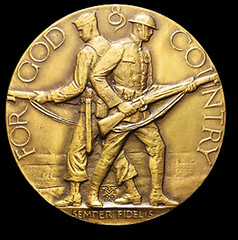 Called “The Great War” and more
optimistically “The War to End All Wars,” World War I was an event that changed the world’s political map and the fabric of civilization. One hundred years ago, more than 17
million people perished, and this unprecedented bloodshed was accompanied by social upheaval and revolution as ancient empires crumbled and new nations were established. This
exhibit uses money and medals to illustrate the events and effects of World War I politically, economically and socially.
Called “The Great War” and more
optimistically “The War to End All Wars,” World War I was an event that changed the world’s political map and the fabric of civilization. One hundred years ago, more than 17
million people perished, and this unprecedented bloodshed was accompanied by social upheaval and revolution as ancient empires crumbled and new nations were established. This
exhibit uses money and medals to illustrate the events and effects of World War I politically, economically and socially.
The initial combatants were Germany, Austria-Hungary and the Ottoman Empire as the Central Powers; and Montenegro, Serbia, Russia, France, Japan, Belgium and Great Britain as the Entente. The war grew to encompass nations from across the globe, with battlefields in Europe, Asia, Africa, the Pacific and most of the world’s seaways. Warfare was industrialized with horrific new weapons while propaganda campaigns ensured that civilians supported the war no matter what the cost.
Eastern Europe was destabilized — the Habsburg and Russian Empires collapsed, and left civil war and anarchy in their wake. The new order in Eastern Europe was even more brutal and oppressive than the old. In Western Europe, Great Britain and France were weakened and Germany was crippled and resentful — setting the stage for World War II. The collapse of the Ottoman Empire resulted in the redrawing of the Middle Eastern map with consequences still relevant today.
Economically, the war caused the collapse of the gold standard, which had done much to create the prewar era of international trade and economic expansion. Free trade was replaced by protectionism and international trade took over 80 years to recover as a percentage of global economic prosperity.
The entry of the United States into World War I in April of 1917 on the side of the Entente was decisive. American industry and agriculture ensured that Great Britain and France could continue to fight in spite of German successes, and American manpower eventually overpowered the German armies on the Western Front. Meanwhile, the U.S. replaced Britain as the world’s banker, becoming the greatest financial power on earth.
These were just a few of the consequences of the shots fired by a young Bosnian-Serb nationalist in Sarajevo on June 28, 1914.
I'm pleased to see more and more online exhibits at numismatic museums everywhere. A great deal of effort goes into planning and creating every exhibit, but only so many people can see it in person before it closes. Exhibit catalogs and books are one good way to document an exhibit's contents, but even those are limited to the relatively small number of people who come into possession of a physical copy. Online exhibits are open to everyone across the world and are inexpensive to maintain. Go ahead and browse - it's a great exhibit. -Editor
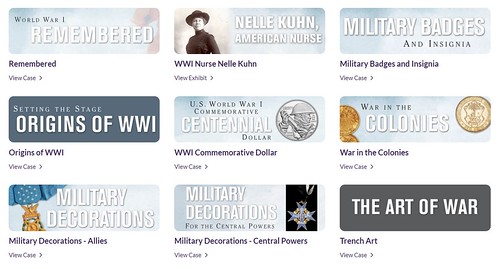
To view the online exhibit, see:
https://www.money.org/money-museum-virtualtour
https://www.money.org/money-museum/virtual-exhibits/wwi
WILLIAM AND CHARLES BARBER EXHIBIT AT WHITMAN EXPO
The groundbreaking exhibit of artifacts relating to U.S. Mint chief engravers William Barber and Charles E. Barber will be on display at the upcoming October 2018 Whitman Baltimore Coin Expo. Here's the press release. -Editor
The Whitman Coin and Collectibles Baltimore Expo will feature two groundbreaking new exhibits and lectures on personal artifacts from the family of U.S. Mint chief engravers William Barber and Charles E. Barber. The Expo is open to the public and runs from Thursday to Sunday, October 25–28, 2018, at the Baltimore Convention Center. The exhibits will be on display through Saturday.
The Barber exhibits are being brought to the Expo by the nonprofit Barber Coin Collectors’ Society (www.barbercoins.org) and Liberty Seated Collectors Club (www.lsccweb.org). Both clubs will hold meetings with educational programs during the Expo, and everyone is invited to attend.
The exhibits include recently revealed personal artifacts from the family archives of William and Charles Barber. These artifacts change the popular conception (and misconceptions) of the father and son who served as the fifth and sixth chief engravers of the United States Mint.
Members of the Trepagnier family, Charles Barber’s descendants who currently own the personal archives and have generously allowed them to be displayed, will be in attendance and will meet collectors and talk about their famous ancestors.
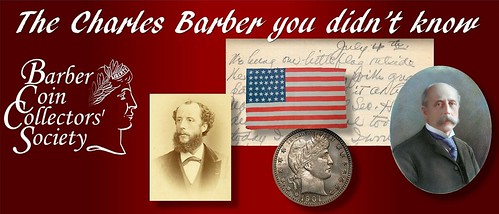
The Charles Barber exhibit includes:
- a painted portrait and six new photographs of Charles E. Barber, which show aspects of his personality not seen in his single previously known portrait
- a photo showing Charles Barber and George T. Morgan together in 1897
- a 39-star flag presented to Charles Barber by President Theodore Roosevelt
- the last remaining five patterns from the famous Charles Barber Collection of patterns still held by the family.
- the first edition of the Woodin-Adams pattern reference, inscribed to Charles Barber, 1913
- key-date Barber coins (Liberty Head nickels, and Barber dimes, quarters, and half dollars)
- Barber’s commemorative coins, Hawaiian coinage, and Cuban coinage
- Barber’s 1905 passport
- memos from U.S. Mint departments for Barber’s 1905 European mint trip, some with his handwritten notes
- a diary of Edith Barber from the family’s European trip, which sheds new light on her father’s relationships
- copies of Barber’s 1905 trip report, with results matching handwritten notes
- a 1906 Mint Assay medal, in its original case, portraying Theodore Roosevelt
- letters to Charles Barber from Augustus Saint-Gaudens and Victor David Brenner
On Friday, October 26, at 3:00 p.m., the Barber Coin Collectors’ Society will present a free educational program entitled “The Charles Barber You Didn’t Know,” in Room 301 of the Convention Center.
Whitman publisher Dennis Tucker has viewed the artifacts and attended an August 2018 presentation by BCCS president John Frost at the American Numismatic Association World’s Fair of Money in Philadelphia. Tucker called Frost’s research and the generosity of the Trepagnier family “one of the most important numismatic developments of the 21st century.” The research will be featured in the second edition of the Guide Book of Barber Silver Coins, by Q. David Bowers, which will debut this holiday season.
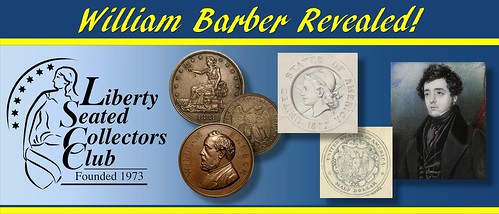
A second exhibit will feature artifacts relating to William Barber—Charles’s father and the fifth chief engraver of the Mint, designer of the U.S. trade dollar and the twenty-cent piece. On display will be:
- an 1869 presidential proclamation naming William Barber as engraver, from President Andrew Johnson and Secretary of State William Seward
- paintings of William Barber and his wife, Anna Maria Barber
- a portrait medal of William Barber by Charles E. Barber
- three original pencil/pen coin design sketches by William Barber
- a U.S. Centennial medal, and Grant second inaugural medal, by Barber
- a scan of an 1875 letter by William Barber about Carson City Mint dies and breakage
- an 1875-CC twenty-cent piece struck from a broken reverse die
- a memo by Mint officials on the death of William Barber
- a set of trade dollars
- a set of twenty-cent pieces, including one of William Barber’s patterns
- a copy of Medallic History of the United States 1776–1876, first edition, by J. Loubat, inscribed to William Barber, 1878
- nside the Mint Cabinet, by Elizabeth Johnston, inscribed to William Barber, 1876
The Liberty Seated Collectors Club meeting will be held Friday, October 26, at 9:00 a.m., in Room 301 of the Convention Center. Its educational program is “William Barber Revealed!”
The Whitman Coin and Collectibles Baltimore Expo is a leading hobbyist convention in North America, held thrice yearly at the Baltimore Convention Center. It connects hundreds of coin and paper-money dealers with thousands of collectors, and is a venue for educational programs, club meetings, new book launches, and social activities for hobbyists from around the world. More information is online at Expo.Whitman.com .
Dave Harper of Numismatic News published an October 5, 2018 column about the new view of Charles Barber. -Editor
Chief Mint Engraver Charles E. Barber has been portrayed as someone of little talent and touchy ego who watched as Augustus Saint-Gaudens, Bela Lyon Pratt, and Victor David Brenner ran rings around him.
An often used photograph of the chief engraver, who served 1880-1917, shows him as an old man with hands folded.
There is no defense against being old, and writers have created a portrait of a crotchety man who owed his position to his father, William, who had died suddenly in 1879.
Ground-breaking research by the Barber Coin Collectors’ Society and the Liberty Seated Collectors Club is slowly changing that perception.
We are learning just how much of what we thought we knew about Charles Barber is simply baseless caricature.
To read the complete article, see:
Mint’s Charles E. Barber gets historical makeover
(http://www.numismaticnews.net/buzz/mints-charles-e-barber-gets-historical-makeover)
MUSEUM RECEIVES TEXIAN NAVY SCRIP
Mike Marotta has made a donation of rare Texas Republic pay warrants to a Military Forces Museum. He kindly provided these photos and press release. -Editor
On September 26, 2018, the Brigadier General John C. L. Scribner Texas Military Forces Museum at Camp Mabry received a gift of two pay warrants issued to sailors and marines of the Texian Navy. They are now part of the museum’s permanent collection and will soon be on display. The pay warrants were donated by Michael E. Marotta, who serves as a petty officer 2nd class in the Maritime Regiment of the Texas State Guard within the Texas Military Department.
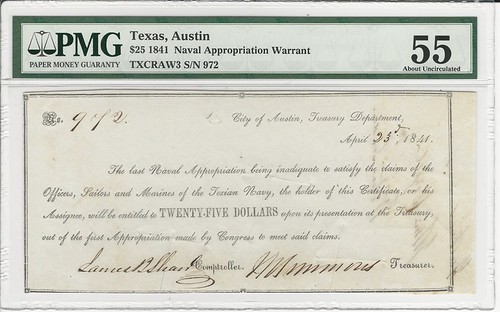
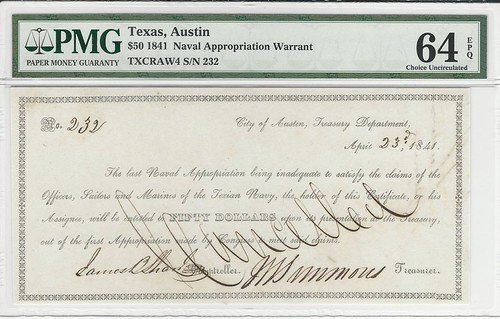
Both warrants are dated April 23, 1841. On the orders of President Mirabeau Lamar, $200,000 in promissory notes were printed, signed, and distributed to sailors and marines in Galveston. The notes are signed by the Comptroller, James R. Shaw, and the Treasurer, James W. Simmons. They are endorsed on the back by the men who whom they were given. Both notes are cancelled. The $25 promise carries the endorsement of John Deziel. The $50 note was paid to a Navy Yeoman. To be paid, the holder had to travel back to Austin, Texas, 200 miles away.
Like other Texas Republic paper money, the promissory notes quickly lost value and few were ever redeemed. The pay warrants now owned by the TMF Museum were actually cashed in and cancelled.
The only hard money available came from $8,000 in silver coin paid to the Texian Navy by Mexican federalist rebels at Yucatan. Most of those pesos went to refitting the fleet. Little was left over to make good on the warrants. In addition. very few promises were honored because as soon as Sam Houston was re-elected President on December 21, 1841, he repudiated the notes. Soldiers serving in the army were given land grants in November 1841, but once in office, President Houston ignored the articles of the law that included the sailors. Houston distrusted the Navy because its victories upset his plans for a helpless Texas Republic to be rescued and annexed by the United States of America. During his first term of office in 1838 Houston declared them all pirates, ordering any lawful ship to arrest them and bring them to Galveston for trial. That did not happen.
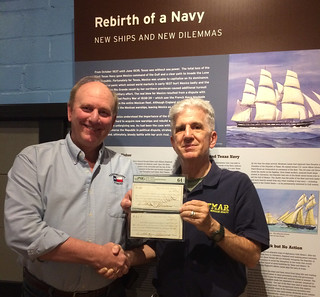
Texas Military Forces Museum director, Jeff Hunt, and museum supporter, Mike Marotta (PO2 TX), stand in front of a Texian Navy display with the pay warrants. (TMF Museum staff photo.)
For more information on the Texas Military Forces Museum, see:
Texas Military Forces Museum (http://texasmilitaryforcesmuseum.org/)
EXHIBIT EXPLORES ELECTRONIC MONEY
The Galt Museum of Albert, Canada is hosting a traveling exhibit from the Bank of Canada Museum about electronic currency. Here's an excerpt from an article about it from the Lethbridge Herald. -Editor
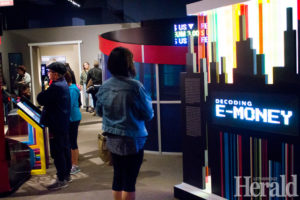 From beaver pelt counters to bitcoins, North
Americans have invented many kinds of “money.”
From beaver pelt counters to bitcoins, North
Americans have invented many kinds of “money.”
Northern trading posts would use special sticks to measure how many pelts were being bought – and how much the trapper could receive. By comparison, it’s more difficult to explain how some of the latest “e-money” programs actually work.
But that’s one of the objectives at “Decoding E-money,” the latest feature at the Galt Museum.
It’s an interactive exhibit that’s travelling the country, explains Galt curator Aimee Benoit. But for the Bank of Canada Museum creation, it’s the first stop in Western Canada.
It opened Sunday “with the hope to broaden the understanding of digital currencies,” she says. Visitors will be invited to experience the displays “through a fun and compelling hands-on context.”
Looking back, however, the exhibit also includes colonial and Canadian coins, bank notes and paper currency covering several centuries.
Coins or bills from various nations – Spain, France, England and more – were in circulation before Confederation in 1867, Benoit notes. And paper money was issued by several institutions before the Bank of Canada was created during the depths of depression, in 1935.
For many Canadians, the first hint of the role digital currency would play was – zip, zip – the first Chargex card. Those early cards are also part of the exhibition, which will remain on view until Jan. 8.
To read the complete article, see:
https://lethbridgeherald.com/news/lethbridge-news/2018/09/25/galts-money-exhibit-explores-currency/
(https://lethbridgeherald.com/news/lethbridge-news/2018/09/25/galts-money-exhibit-explores-currency/)
Here's more information from the museum's web site. -Editor
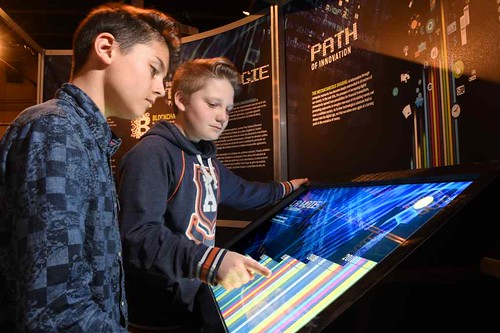
It's in your gift cards and maybe even your transit pass. It's starting to appear on your phone. How far is it going to go?
Decoding E-Money is a travelling exhibition from the Bank of Canada Museum that explores the past, present and future of electronic money and electronic payment systems. While raising awareness of e-money, this exhibition also helps visitors understand the possible effects of the widespread use of one form of e-money: digital currency.
Decoding E-money explores the voyage of your dollars from purchase to deposit through various traditional and e-payment systems. Learn about a whole new kind of money as cutting-edge graphics and fun, interactive displays introduce you to the high-tech intricacies of Bitcoin and other web-based currencies. Explore more than 60 artifacts covering the way Canadians have spent their money over the course of 200 years. From trading tokens to the most recent precursors of today’s e-money, these artifacts at one time challenged our notions of acceptance much the way that Bitcoin challenges us today.
The exhibit includes games that help players experiment with and understand more deeply the philosophies and principles behind various e-money transaction tools from credit and debit cards, to cryptocurrencies and blockchain. One of the aspects that games will underline is the intense competition involved in verifying and completing digital transactions so they become permanent and unchangeably embedded in a public transaction record. The technology that enables this form of decentralized currency has the potential to bring fundamental change to existing financial systems and is of great interest to the Bank of Canada and other central banks.
To read the complete article, see:
Decoding E-money
(https://galtmuseum.com/index.php?seotitle=decoding-e-money&plugin=event)
JOHN MAX WULFING COLLECTION CATALOGUER SOUGHT
A position is open for working with the John Max Wulfing Collection of Ancient Coins at Washington University in St. Louis. -Editor
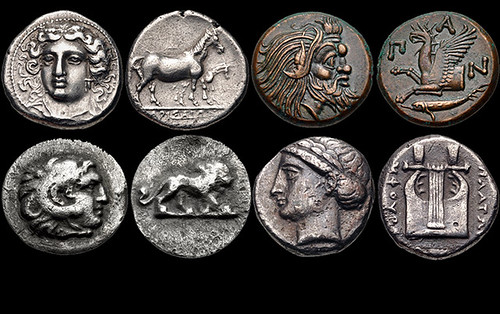
Washington University in St. Louis seeks to appoint a full-time Postdoctoral Fellow to catalogue the John Max Wulfing Collection of Ancient Coins. The Wulfing Collection of nearly 16,000 objects consists primarily of ancient Roman, Byzantine, and Greek coins and ranks as one of the largest numismatic collections at a North American college or university. The Fellow will be based in the Department of Classics and will teach one course per year for the department, but their principal duties will be to develop and implement a cataloguing system and to aid the Curator (a member of the Classics faculty) in tasks related to management of the Collection.
The successful candidate will have a PhD in a relevant field in hand by July 1, 2019, possess extensive numismatic expertise in the coinages of the ancient Mediterranean world, and show evidence of scholarly promise. Any prior experience as a Postdoctoral Fellow elsewhere must be limited to two years. The position will require the Fellow to perform all aspects of cataloguing (including photography, scanning of archival materials, and preparation of the digital catalogue). No specific course is required for the teaching element of the Fellowship, but the successful candidate is expected to be competent in teaching the classical languages, to make a significant contribution to the graduate and undergraduate programs in Classics, and to participate in the intellectual life of the department.
The initial appointment will be for a two-year term, with a possibility of renewal after the second year. The Curator will serve as the Fellow’s mentor, helping the Fellow further master the skills associated with the fellowship, plan individual research, and prepare for a career in the field.
Applicants should submit a cover letter, a curriculum vitae, a sample of scholarly writing, course evaluations or other evidence of teaching excellence, and three letters of recommendation by Dec. 1, 2018. All materials should be sent via email to classics- search@wustl.edu. Inquiries may be sent to Cathy Keane, Chair of the Department of Classics (ckeane@wustl.edu). Members of the search committee will conduct its first short-list interviews via Skype.
For more information on the collection, see:
Discover the John Max Wulfing coin collection (https://classics.artsci.wustl.edu/photos/33)
OCTOBER 2018 MEDAL SELECTIONS FROM NUMISMAGRAM
Jeremy Bostwick forwarded along these four medals from the recent additions to his site at Numismagram. An array of attractive art and historical medals, along with a few plaques, are available for your consideration, and cover some interesting topics such as architecture, Napoleonica, Americana, and of course, Washingtoniana. Visit numismagram.com/inventory/ to view all of them. -Editor
Austria Gambrinus Medal
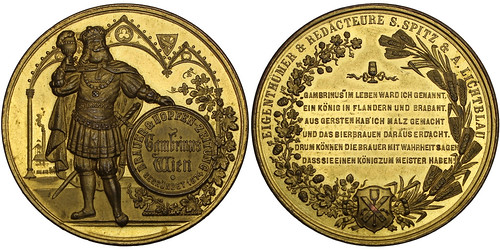
100388 | AUSTRIA. Wien (Vienna). Gambrinus gilt bronze Medal. Gambrinus (legendary king of Flanders known for his mythical brewing abilities) standing facing, in regal attire, head right, holding chalice of beer and resting hand upon shield to right, surrounded by hop vines with cones and inscribed BRAUER & HOPFEN-ZEITUNG / Gambrinus / Wien / GEGRÜNDET 1874; Gothic portico in background / EIGENTHÜMER & REDACTEURE S. SPITZ & A. LICHTBLAU (Spitz & Lichtblau, owners and editors), „GAMBRINUS” IM LEBEN WARD ICH GENANNT, / EIN KÖNIG IN FLANDERN UND BRABANT. / AUS GERSTEN HAB’ICH MALZ GEMACHT / UND DAS BIERBRAUEN DARAUS ERDACHT. / DRUM KÖNNEN DIE BRAUER MIT WAHRHEIT SAGEN / DASS SIE EINEN KÖNIGZUM MEISTER HABEN! (Gambrinus was, in life I say, a king of Flanders and Brabant. Made from malted barley, the brewing of beer is thus begun. Go forth and tell the brewers verily that you have a king of masters!) in six lines; garlanded chalice above; all within wreath comprised of barley grains hop vines with cones, and with shield containing mash paddle at base. Edge: Plain.
Wurzbach 9582. Choice Mint State. Lustrous yellow-bronze surfaces, with an alluring radiance.
Essentially a 'BeerAdvocate' of its time, the Brauer & Hopfen-Zeitung (Brewer and Hop Journal) Gambrinus was an Austrian publication which focused on the beer industry not just within the Austro-Hungarian Empire, but throughout Europe as well. For its name, the editors chose Gambrinus, the legendary king of Flanders and Brabant who was emblematic with joviality and the art of brewing.
What's your superpower? Mythical brewing abilities! -Editor
To read the complete item description, see:
100388 | AUSTRIA. Wien (Vienna). Gambrinus gilt bronze Medal. (https://www.numismagram.com/product-page/100388)
Hague Peace Conference Medal
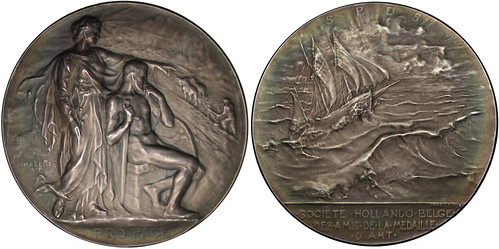
100406 | BELGIUM & THE NETHERLANDS. Silver Medal. Issued 1907. The Belgo-Dutch Society of the Friends of Medallic Art: The Peace Conference at the Hague (64mm, 110.02 g, 12h). By Hippolyte le Roy.
Swords to Plowshares: War seated right upon plinth, in attitude of contemplation, cradling reversed sword and with shield to right; behind him, Peace standing right, holding branch and pointing out to him a different path; farmhand plowing in background to right; PRO PACE (for peace) in exergue / SPES (hope), ship under sail right upon tempestuous seas; in background, rising sun emerging from the clouds and horizon; in three lines in exergue, SOCIÉTÉ HOLLANDO BELGE / DES AMIS DE LA MÉDAILLE / D'ART. Edge: Plain, though a light mark is noted for completenes.
Médailles historiques de Belgique III 26; cf. Catalogue of the International Exhibition of Contemporary Medals p. 194, 9 (bronze). Choice Mint State. Sublimely matte surfaces, with an attractive steel-gray cabinet appeal and rainbow tone near the peripheries. Extremely rare and interesting, with a mintage of just 51 pieces in silver. Compare to a similar example in Schulman 356 (29 June 2018), lot 1168 (which realized a hammer of €1,400 [plus buyer's fee]).
Proposed by U.S. President Theodore Roosevelt in 1904, the Second Hague Peace Conference didn't convene until 1907 due to the Russo-Japanese War of 1904-1905. Called to order by Czar Nicholai II of Russia, the conference sat for four months, during which it further addressed the rules of engagement during warfare and its aftermath, such as several naval-related tactics and outcomes, while stopping short of reaffirming the ban of expanding bullets and asphyxiating gas (both of which had been outlawed at the previous Hague Peace Conference in 1899). The hope expressed at this conference, conveyed through this gorgeous medal, was met with despair just a few years later with the outbreak of World War I in 1914.
A sadly beautiful medal. -Editor
To read the complete item description, see:
100406 | BELGIUM & THE NETHERLANDS. Peace Conference silver Medal.
(https://www.numismagram.com/product-page/100406)
Sweden Oscar II Horse Breeding Medal
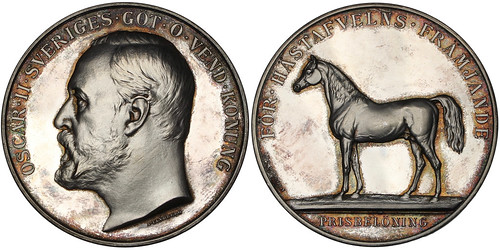
100405 | SWEDEN. Oscar II silver Award Medal. Issued circa 1905-1907. Presented for Horse Breeding (43mm, 40.02 g, 12h). By A. Lindberg & L. Ahlborn. OSCAR II SVERIGES GÖT O VEND KONUNG, bare head left / FÖR HÄSTAFVELNS FRÄMJANDE (for horse breeding), horse standing left; PRISBELÖNING (award). Edge: Plain.
Choice Proof. Exceedingly lustrous and mirrored, with supremely frosted devices and an alluring burnt sienna and deep crimson tone near the peripheries; a fair number of hairlines in the fields are noted.
Awarded annually by the Stuteri Öfverstyrelsen (stud farm executive board), these medals were a continuation of the ideals originally promoted in the 17th century in order to foster a strong supply of horses for the Swedish cavalry. Enacted by decree in 1872, and officially instituted by 1875, these hästmedaljer ("horse medals") were presented, in silver and bronze, to the owners of deceased young horses that were considered by the board to be worthy of such honor and distinction.
To read the complete item description, see:
100405 | SWEDEN. Oscar II silver horse breeding Award Medal. (https://www.numismagram.com/product-page/100405)
Washington Samson Medal Restrike
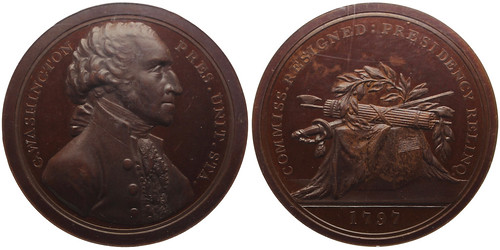
100435 | UNITED STATES. George Washington bronze Medal. Restrike issue, struck circa 1859-1870. Sansom/The Presidency Relinquished (40.8mm, 12h). By J. Reich.
G WASHINGTON PRES UNIT STA, uniformed bust right / COMMISS RESIGNED PRESIDENCY RELINQ, draped plinth decorated with Union shield and surmoutned by wreath, sword, and fasces. Edge: Plain.
Musante GW-59; Baker 72A; Julian PR-1. Graded NGC PF64 Red Bronze. Deep red-brown surfaces, with immense luster and brilliance. For cert verification, please follow this link: .ngccoin.com/certlookup/1820209-039/64/.
The dies for this ever-popular and alluring piece were originally engraved by John Reich in 1807. Half a century later, a new reverse die was created using hubs taken from the original, and a series of restrikes and off-metal strikes were produced over the decade of the 1860's. A keystone example within the field of Washingtoniana.
Indeed. Nice medal. -Editor
To read the complete item description, see:
100435 | UNITED STATES. George Washington bronze Medal. (https://www.numismagram.com/product-page/100435)

MICHAEL GIETZELT COLLECTION OF MILLED COINS
Dix Noonan Webb of London are offering the Michael Gietzelt collection of British and Irish milled coins. Here's the press release. -Editor
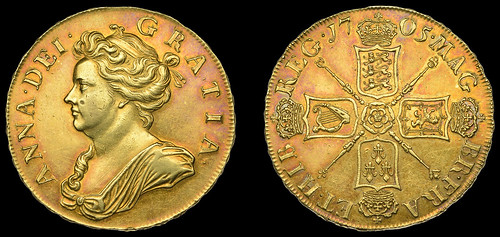
A Queen Anne Five Guineas from 1705 is expected to fetch up to £30,000
The collection of British and Irish milled coins formed by the Berlin-based dealer and collector Michael Gietzelt is to be auctioned by Dix Noonan Webb, the international coins, medals, banknotes and jewellery specialists, in London on 14 November 2018. The collection, which includes coins from the reign of Charles II through to the 20th century, forms almost 400 lots and is expected to fetch up to £575,000.
Michael’s Gietzelt’s fascination with British numismatics began when his mother presented him with some worn Victorian pennies and his great-grandfather gave him his first serious coin – an 1887 Five Pounds piece. Since then his collection has expanded to cover coins from Edward III to the present day as well as orders, decorations, medals and paper money from the British Isles.
With the dispersal of his milled coins he will now focus on the hammered series, including Scottish and Irish issues, while maintaining his collections of coins and tokens of the Isle of Man and the Channel Islands.
Among the highlights of the Gietzelt Collection to be auctioned at Dix Noonan Webb are a Five Guineas dated 1705 from the reign of Anne (1702-1714), which is expected to fetch £24,000 to £30,000, a George IV (1820-1830) Proof Five Pounds from 1826, estimated at £20,000 to £26,000, and a 1691 William and Mary (1688-1694) Five Guineas, which should sell for £15,000 to £20,000.
The collection also includes a number of Proof Sets, including a George V one from 1911, estimated at £10,000 to £12,000, and a George VI set dated 1937, expected to sell for £8,000 to £10,000. A 30-lot section of Irish coins includes a Wood’s coinage Proof Farthing dated 1723, estimated at £4,000 to £6,000, and a George IV Proof Farthing from 1822 which carries an estimate of £1,500 to £2,000.

William and Mary Five Guineas from 1691
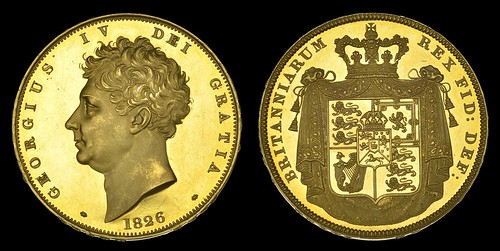
The 1826 George IV Proof Five Pounds
Michael Gietzelt was born in Berlin in 1954, the son of a doctor. Educated at Berlin Secondary School, he performed his military service in the Medical Corps, attaining the rank of sergeant, before entering Berlin University to study medicine in 1975. Within two years he had decided that medicine was not the career choice for him and he opened his antique shop on the Frankfurter-Alle in Berlin in 1977. Together with his wife Gisela, Michael also collects German porcelain, particularly Meissen, while their busy home life revolves around their five children and ten grandchildren.
For more information, see:
https://www.dnw.co.uk/
STACK'S BOWERS OCTOBER 2018 SALES SELECTIONS PART 1
Here's a selection of items that caught my eye in the upcoming Stack's Bowers sales. More to come in subsequent issues. -Editor
Lot 3: 1783 Treaty of Paris Medal
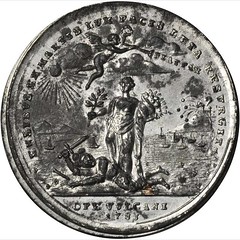
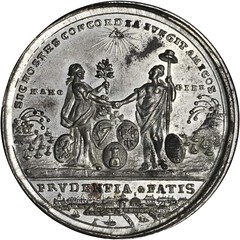
1783 Treaty of Paris Medal. White Metal, with Copper Plug. 42.9 mm. By John Reich. Betts-610, Eimer-804, BHM-255. About Uncirculated
To read the complete lot description, see:
1783 Treaty of Paris Medal. White Metal, with Copper Plug. 42.9 mm. By John Reich. Betts-610, Eimer-804, BHM-255.
(https://auctions.stacksbowers.com/lots/view/3-DFOJG)
Lot 15: Kittanning Destroyed Medal
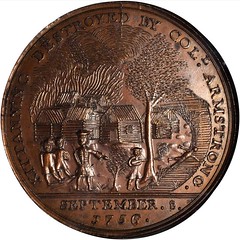
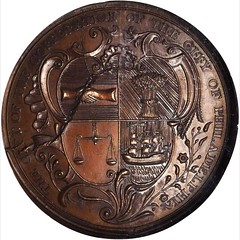
"1756" (ca. 1860-1874) Colonel John Armstrong / Kittanning Destroyed. Original Dies Restrike. Bronze. 44 mm. Julian MI-33. MS-66 BN (NGC).
Gorgeous mahogany-brown surfaces with fully defined design elements and satiny, virtually pristine surfaces. These dies were the first medal dies ever produced in what became the United States, authorized by the city of Philadelphia to decorate veterans of a raid on a Native American village near modern day Pittsburgh. Those veterans received silver medals struck over smoothed Pillar 8 reales. The U.S. Mint produced restrikes from these dies from the earliest days of the 19th century through about 1874. The present example is one of those restrikes, although it is not among the latest since the die cracks are not as advanced as we have seen on some pieces. Even so, we note an obverse crack through the final letter D in DESTROYED. The reverse is bulged with three prominent cracks radiating out from the center.
To read the complete lot description, see:
"1756" (ca. 1860-1874) Colonel John Armstrong / Kittanning Destroyed. Original Dies Restrike. Bronze. 44
mm. Julian MI-33. (https://auctions.stacksbowers.com/lots/view/3-DFNFH)
Lot 112: 1903 Amerigo Vespucci Plaque

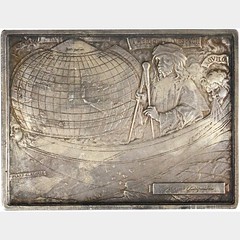
1903 Amerigo Vespucci Plaque. Silver. 76.2 mm x 57.8 mm. 121.4 grams. By Victor D. Brenner. Miller-15, Smedley-50. About Uncirculated.
A 400th Anniversary commemorative by the ANS remembering the contributions made by Amerigo Vespucci who claimed that the new lands being discovered across the Atlantic were not India, but an entirely new continent. A rare medal, 101 struck, by Victor D. Brenner of Lincoln cent fame. This example with a lovely matte pearl gray patina and no significant nicks or abrasions. Numbered 25 on the edge, but an error in the placement of the digits makes it possible to interpret them as 52 or 25. Very rare and desirable.
Provenance: Ex Geraldine Rockefeller Dodge Collection; our Baltimore Auction of June 2012, lot 369. Lot tag included.
-Editor
To read the complete lot description, see:
112 1903 Amerigo Vespucci Plaque. Silver. 76.2 mm x 57.8 mm. 121.4 grams. By Victor D. Brenner. Miller-15,
Smedley-50. (https://auctions.stacksbowers.com/lots/view/3-DFOKO)
Lot 134: 1900 Bryan Dollar HK-783
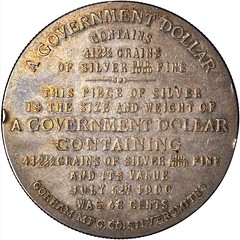

1900 Bryan Dollar. Silver. 37.8 mm. 26.8 grams. HK-783, Schornstein-12. Rarity-6. Extremely Fine.
To read the complete lot description, see:
1900 Bryan Dollar. Silver. 37.8 mm. 26.8 grams. HK-783, Schornstein-12.
(https://auctions.stacksbowers.com/lots/view/3-DFRGM)
Lot 159: 1858 Lovett Atlantic Telegraph Token
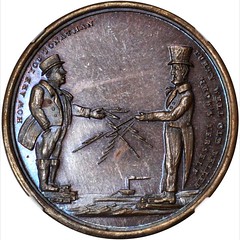

New York--New York. 1858 George H. Lovett. Miller-NY 493A. Copper. 31 mm. MS-64 BN (NGC).
A very interesting and historical piece. -Editor
To read the complete lot description, see:
159 New York--New York. 1858 George H. Lovett. Miller-NY 493A. Copper. 31 mm. MS-64 BN (NGC).
(https://auctions.stacksbowers.com/lots/view/3-DFQCV)
NUMISMATIC NUGGETS: OCTOBER 7, 2018
Here's a selection of interesting or unusual items I came across in the marketplace this week. Tell us what you think of some of these. -Editor
French Fencing Medal
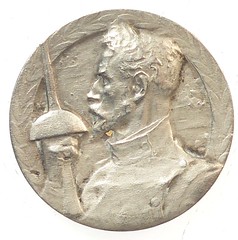
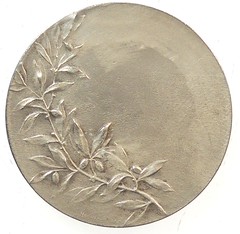
There are plenty of sports medals around, but fencing isn't often a subject. Interesting medal. -Editor
To read the complete lot description, see:
France sports FENCING silvered-bronze 40mm (https://www.ebay.com/itm/163291530731)
1923 German 5 Billion Mark Banknote
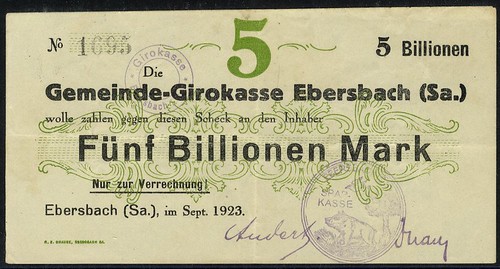
Germany 5 billion mark banknote
Germany 5 billion mark 1923 Ebersback, VF.
Now that's a large denomination note. Interesting 1920's German hyperinflation relic. -Editor
To read the complete lot description, see:
Germany 5 billion mark banknote (https://www.corbitts.com/stampsandcoins/germany_5_billion_mark_banknote/
detail.html?e=100a6c8ad71b6c32b1477d923bb9d8915c110ea80667
4e49954f2200d0cd5fd85fd9142dc890c86cd1d0
9563dfdfd07147e4b0b413a10f09d656e99dca83264d&f=1659)
Alaska Palmer Correctional Center Tokens

Description: Lot of three tokens: 5c, 10c and 25c. All brass and round. The Palmer Correctional Center opened in 1983. City: Palmer State: Alaska Date: HWAC# 78553
From the upcoming Holabird sale. But why is the 10 smaller than the 5? I assume they were taking the sizes from circulating U.S. coins, and the dime (made of silver) is smaller than the nickel. -Editor
To read the complete lot description, see:
Lot 2410: Palmer Correctional Center Tokens (https://www.invaluable.com/auction-lot/-1-c-98F4D9BB55)
Dollar Bill Signed by Andy Warhol

WARHOL Andy
"One Dollar signed"
1 dollar banknote signed in black marker.
Dimensions: 6.5 x 14 cm
This item is sold by a professional art dealer who guaranties its authenticity
To read the complete lot description, see:
WARHOL Andy : « One Dollar signed »
(https://www.lotprive.com/en_GB/buy/contemporary-art/warhol-andy-one-dollar-signed-432777)
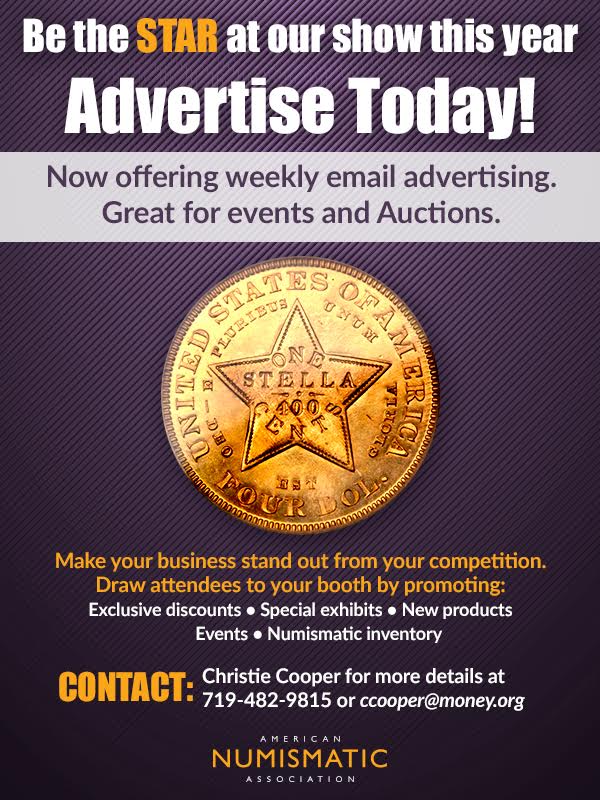
COLONIAL AMERICAN LOTTERY TICKETS
Colonial-era lottery tickets are a fascinating area to collect and study. While not strictly numismatic, they are akin to colonial paper money, produced by many of the same printers and using the same materials. Pablo Hoffman passed along this April 21, 2017 Atlas Obscura article. Thanks. -Editor
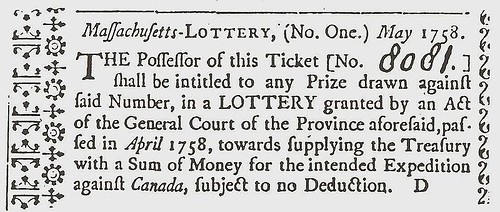
IN THE LATE 19TH CENTURY, Ainsworth Rand Spofford, the sixth Librarian of Congress, went looking through America’s early newspapers for the the earliest notice of a lottery he could find. What he found had been published in February 1720, in the American Weekly Mercury. This lottery was not the colonies’ first, Spofford cautions—only the first for which he could find a printed notice. The ad promised 350 tickets would be sold, for 20 shillings a piece.
The prize? “A new brick house, corner of Third and Arch,” in Philadelphia.
As Philadelphia came to surpass Boston as the colonies’ largest city, its growth was funded in no small part by lotteries. “It was looked upon as a kind of voluntary tax for paving streets, erecting wharves, buildings, etc., with a contingent profitable return for such subscribers as held the lucky numbers,” wrote Spofford in 1893.
Philadelphians used lotteries to build a battery on the Delaware River to defend the city, span creeks with bridges, and fund roads that led from the countryside into the city. But it was far from the only city in the American colonies that depended on people’s willingness to try their luck. In the 17th and 18th centuries, lotteries were a thriving business, both public and private, and without them, early America couldn’t have been built.
When the colonies revolted against the crown, lotteries helped the new United States of America survive. In 1776, the Constitutional Congress held one to benefit the soldiers of the Revolution. (Since the value of the new country’s currency was fluctuating wildly, it was less successful than hoped.) Once the colonies won the war, the new states leaned heavily on lotteries to raise revenue, in part because they were not eager to tax newly independent citizens who’d just rebelled against taxation by a central authority. Lotteries funded the growth of the country’s earliest colleges, including the College of New Jersey (later Princeton), Dickinson College, Harvard, and Yale, of many, many churches, and of iconic buildings, including Boston’s Faneuil Hall, which needed to be rebuilt after it burned down in 1761.
To read the complete article, see:
Colonial America Was Built on Lottery Revenue
(https://www.atlasobscura.com/articles/early-american-lottery-ticket-colonial)
19TH CENTURY EXPOSITION MEDAL COLLECTION
Harry Waterson writes:
Attached are photos of a 1902 sign that is amazing. The eBay # is 362450025095. It is for the very advanced chocoholic.
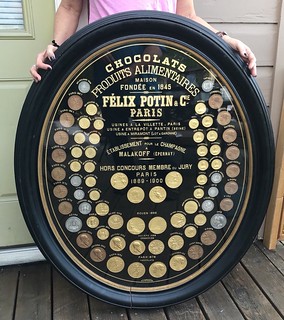
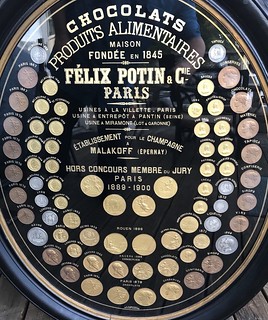
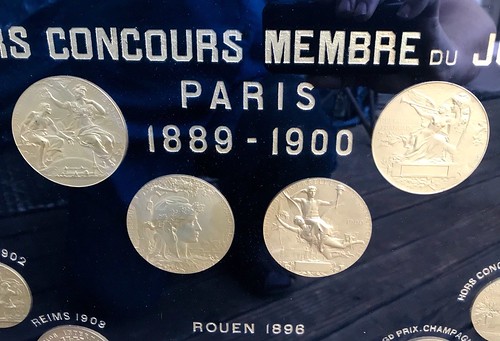
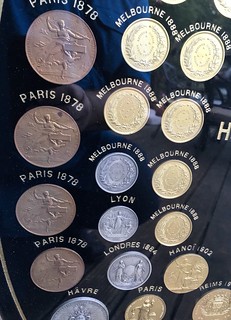
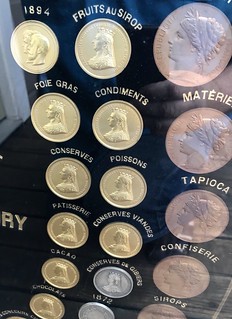
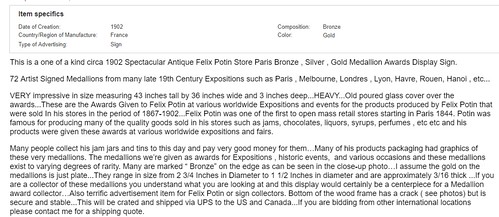
Thanks. Amazing, indeed. What a great collection. Forget the food and chocolate - gimme the medals. -Editor
PRESIDENT TRUMP AWARDS MEDAL OF HONOR
A Medal of Honor ceremony was held at the White House this week. -Editor
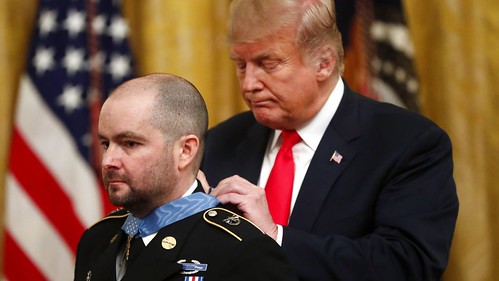
President Trump on Monday awarded the military's highest honor to a former U.S. Army medic and Green Beret who saved soldiers' lives during a battle with terrorists in Afghanistan in 2008.
Former Staff Sgt. Ronald J. Shurer II, of Alaska, received the Medal of Honor during a ceremony at the White House. Trump said it was a "proud and special day for those of us here in the White House because Ron works right here alongside us," with the U.S. Secret Service.
"For more than six hours, Ron bravely faced down the enemy," Trump said during Monday's ceremony. "Not a single American died in that brutal battle thanks in great measure to Ron's heroic actions."
Ahead of officially awarding Shurer the prestigious honor, Trump explained that Shurer was initially rejected from the military "due to a medical condition." He said that after the terrorist attacks of 9/11, Shurer reapplied and was accepted in the U.S. Army in 2002, in which he became a medic and a Green Beret.
To read the complete article, see:
Trump awards Medal of Honor to former Army medic
(https://www.foxnews.com/politics/trump-awards-medal-of-honor-to-former-army-medic)
1976 QUEEN ELIZABETH II US BICENTENNIAL MEDALS
As noted in an article elsewhere in this issue, Assay Commissioner Charlie Long of Charlottesville, Virginia helped create a Bicentennial medal for Queen Elizabeth II. But why - what was the connection? Well, Her Highness visited the former colony of Virginia in 1976. Here's an excerpt from an account of the event from the Daily Progress. -Editor
 Queen Elizabeth
II and her husband Prince Phillip paid a royal visit to Monticello and the Grounds on this day in 1976 as part of their six-day Bicentennial state visit to England’s former
colonies. Hosting dignitaries had become commonplace for the city, but a visit from a royal brought a special sense of importance.
Queen Elizabeth
II and her husband Prince Phillip paid a royal visit to Monticello and the Grounds on this day in 1976 as part of their six-day Bicentennial state visit to England’s former
colonies. Hosting dignitaries had become commonplace for the city, but a visit from a royal brought a special sense of importance.
While Charlottesville would be a logical destination for a royal bicentennial visit with its deeply rooted ties to the Declaration of Independence, and despite a formal invitation from Governor Mills Godwin, “the real reason for her coming here was that one of her cousins who is an architect came to Charlottesville in the fall of ’75 on a private visit. He saw Monticello and the university and told the queen she absolutely had to come here during the Bicentennial.”
After the queen’s plane touched down at the Charlottesville-Albemarle Airport, more than 50,000 people lined the motorcade route along U.S. 29. More than 18,000 assembled on the Lawn. Thousands lined the grounds of Monticello. All were hoping to catch a glimpse of the royal.
According to the queen’s private secretary: “She enjoyed her visit because it was so relaxed. They had this hectic, rather pompous schedule and then they got here. It was a beautiful day and everything went perfectly.”
To read the complete article, see:
Queen Elizabeth II paid a
royal visit in 1976 (https://www.dailyprogress.com/125yearsofprogress/queen-elizabeth-ii-paid-a-royal-visit-in/article_49d1634a-6345-11e7-ae55-03c9ef3a1ff7.html)
A sale listing on Worthpoint provides some information. -Editor
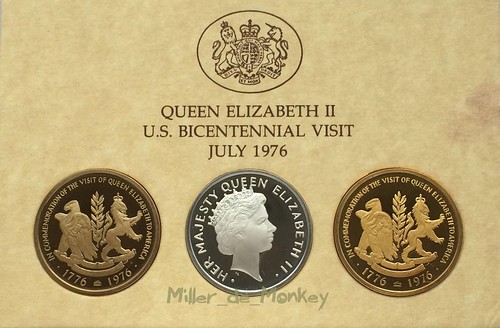
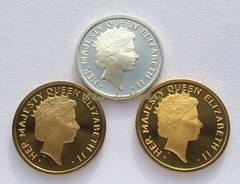
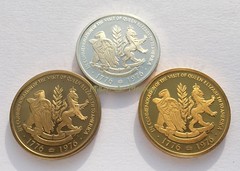
“QUEEN ELIZABETH II: 1976 US BICENTENNIAL VISIT PROOF MEDAL SET By Frank Gasparro”
This is a rare chance to purchase a delightful set of medals that both captured and created a special piece of history. Frank Gasparro was commissioned to create the official medal for Queen Elizabeth’s Bicentennial visit to Monticello, home of Thomas Jefferson, author of the Declaration of Independence and the U.S. third President. The medal marks the first time in the 184 year history of the U.S. Mint that the Chief Sculptor and Engraver has created a coin or medal with the likeness of the Queen of England.
This truly is a highly collectable set of medals in excellent condition. The three medals are made from Solid Bronze, Sterling Silver and Sterling Silver with a 24kt Gold Layer. The sets were limited to 2500 sets of which this is number 94, all the medals have that limited edition number on them as well as the relevant hallmarks.
To read the complete article, see:
QUEEN ELIZABETH II: 1976 US BICENTENNIAL VISIT PROOF MEDAL SET BY FRANK
GASPARRO (https://www.worthpoint.com/worthopedia/queen-elizabeth-ii-1976-bicentennial-1777000455)
THE CASE OF THE SHERLOCKIAN CHOCOLATE COINS
Greg Ruby's Fourth Garrideb blog covers the numismatics of Sherlock Holmes. This September 30, 2018 post covers the case of the Sherlockian Chocolate Coins. -Editor
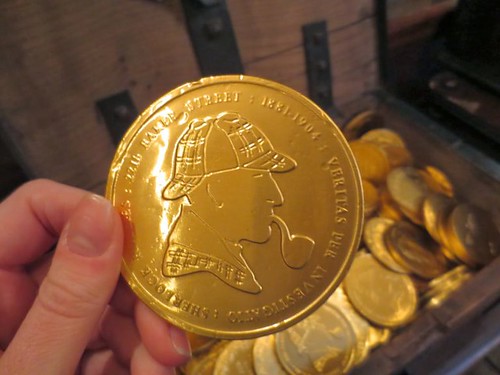
Last August, we published a HolmeWork assignment asking for help in learning more about the chocolate coins that are sold at the Sherlock Holmes Museum on Baker Street. We had a picture of the front (or obverse) of the chocolate coin, but none of the back. We asked two questions:
Anyone with pictures of both sides of this candy? Can anyone make out the wording on the Sherlock Holmes side of the coin in the pictures? We recently came across two pictures that answers those questions.
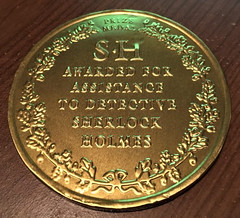
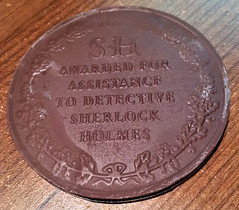
Gotta love the chocolate surface on the second one! For search engines I'll add the text of the inscription: "S H / AWARDED FOR / ASSISTANCE / TO DETECTIVE / SHERLOCK / HOLMES". -Editor
To read the complete article, see:
Sherlockian Chocolate Coins
(https://fourthgarrideb.com/2018/09/30/sherlockian-chocolate-coins/)
COIN MADE WITH WORLD'S OLDEST SCOTCH
Like coins made of chocolate? How about coins made with whiskey? I missed this announcement when it first came out last month, but here's a novel creation - a coin with a finely aged drop of the world's oldest scotch? -Editor
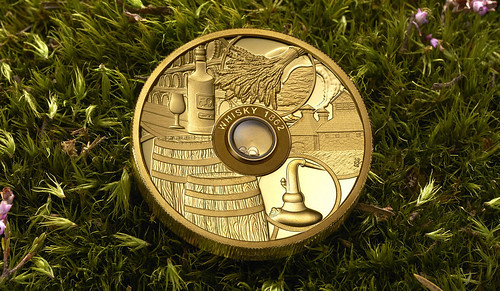
Lux Coin, a manufacturer of the most iconic coins in the world has recently unveiled its new wonder- a gold coin that contains a drop of the very precious Old Vatted Glenlivet 1862 (world’s oldest scotch) at its core. The exclusive Whiskey coin is a work of art like no other and happens to be the world’s first legal tender coin to hold the vintage whisky in it.
As part of the design, the golden goblet features a capsule containing the rare spirit in the middle, with adornments such as a bottle and glass, casks of spirit and sculpted representations of the whisky making process inscribed in its background. Made from 2oz of 99.99% pure gold, the whiskey coin happens to be the first ever to encapsulate such valuable aged liquor in a precious metal of the highest quality. The unique collectible forms part of a legal tender of the Government of Tuvalu and comes with a very limited mintage of only 300. It is also the first of three gold coins from the new Spirit Coins series created by Lux Coin in conjunction with top mints.
To read the complete article, see:
Made of pure gold – The
worlds first whiskey coin has a drop of the worlds oldest scotch in its center
(http://luxurylaunches.com/other_stuff/made-of-pure-gold-the-worlds-first-whiskey-coin-has-a-drop-of-the-worlds-oldest-scotch-in-its-center.php)
PRE-CONQUEST COINS OF WESTEROS
Never heard of Westeros? It's fictional, and so are these coins planned by the Shire Post Mint, a maker of fantasy coins with tie-ins to books. Here's their Kickstarter campaign collecting preorders for the series. -Editor

We are Shire Post Mint. We are a family-run business based in the Ozarks of Arkansas, USA founded in 2003. We make all of our coins in our workshop. We specialize in creating officially licensed solid metal coins from literary series like A Game of Thrones™, The Lord of the Rings™, Mistborn Coins™, The Wheel of Time™, The Kingkiller Chronicle™, The Demon Cycle™, Conan® the Barbarian, and John Carter of Mars™.
We have been working with George R.R. Martin since 2003 to create authentic coins from Westeros and Essos. To date, we have crafted over 40 unique coins from A Song of Ice and Fire.
These coins will be made in solid metals like bronze, copper, iron, nickel, and brass. The designs are hand-engraved in steel and stamped using antique machinery.
The designers have done their homework - the styles are resonant of actual coins. But we in the numismatic community should catalog these somewhere, somehow so that when they start appearing in the secondary market their origin is clear. Here are a few example designs. -Editor
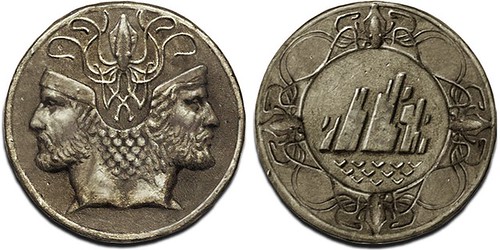
Kings of Salt and Rock fantasy coin
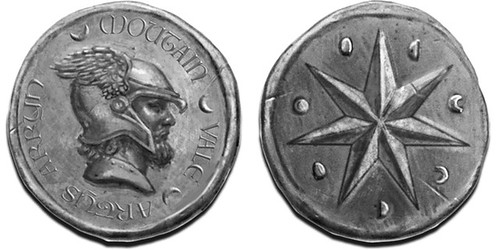
Artys Arryn Star fantasy coin
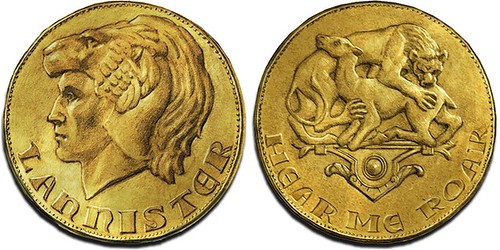
Loreon I Lannister Gold Lion fantasy coin
To read the complete article, see:
Pre-Conquest Coins of Westeros
(https://www.kickstarter.com/projects/shirepostmint/pre-conquest-coins-of-westeros)
LOOSE CHANGE: OCTOBER 7, 2018
Here are some additional items I came across in the media this week that may be of interest. -Editor
Review of the 2019 Blue Book and Red Book
Mike Thorne, Ph.D. wrote a review for Coins magazine of the latest editions of the Handbook of United States Coins (the Blue Book) and the Guide Book of United States Coins (the Red Book). -Editor
When I compare my first Blue Book and Red Book with the current editions, I find that there’s no comparison. My first Blue Book was the 1956 13th edition. Its contents occupied 126 pages. There are 304 pages in the 2019 edition. The page count of my 1958 Red Book, the 11th edition, was 254. The current Red Book boasts 463 pages.
In the 1950s, all the coin pictures were in black and white. Today, they’re all in color in the Red Book (black and white in the Blue Book). I could go on with these comparisons, none of which favor the earlier editions, but you get the picture: the popular Whitman-published books have come a long way in the 60+ years I’ve been collecting.
To read the complete article, see:
Review of the 2019 Blue Book and Red Book
(http://www.numismaticnews.net/article/review-of-the-2019-blue-book-and-red-book)
Coincidentally, Coin Update runs a series of personal reflections about the Red Book, and here is an excerpt from the October 2, 2018 installment written by Gene L. Henry. -Editor
In the fall of 1966, local Seattle coin dealer Sylvester O’Donnell and I started Loose Change, a television show to educate people about what valuable coins they could find in their change. The show would air on Channel 11, KTNT-TV in Seattle-Tacoma.
Luckily for me, I had just returned from the ANA convention, where I met R.S. (Dick) Yeoman. At the show I presented him with my idea of a TV program on coins. Dick Yeoman was our first guest on the first episode of the show. He even sent me 500 new 1967 edition Red Books, which I signed and gave out to viewers who sent in coin questions.
That was over 40 years ago, and I have been a contributor to the Red Book ever since.
Editor’s note: Loose Change, which aired in 1966 and 1967, was the first television program ever aired about collecting coins. Henry has commented that he still believes it would have been a success had it not been scheduled against ABC’s Wide World of Sports!
Interesting. Funny that the name of this coloum is Loose Change as well. I'd never heard of the earlier TV show. It would be great to watch this today. Does anyone know if the videos have survived anywhere? -Editor
To read the complete article, see:
Red Book recollections: Gene L. Henry
(http://news.coinupdate.com/red-book-recollections-gene-l-henry/)
CDN Interviews Dealer Michael Rullo
Editor Joshua McMorrow-Hernandez of Coin dealer Newsletter interviewed dealer Michael Rullo at the recent ANA World's Fair of Money in Philedelphia. Check out the video. -Editor
To read the complete article, see:
New Jersey Coin Dealer Michael Rullo Discusses Marketplace For Budget Coins
(http://blog.greysheet.com/michael-rullo-new-jersey-coin-dealer-insight-on-marketplace/)
The Great Denver Mint Robbery of 1922
From the Littleton Independent in Colorado is this notice of a local Historical Society talk on the 1922 Denver Mint robbery. -Editor
Columbine Genealogical and Historical Society announces October programs. Guests and new members welcome. The group meets at Lutheran Church of the Holy Spirit, 6400 S. University Blvd., Centennial. Free. From 1 to 3 p.m. on Oct. 9 will be “The Great Denver Mint Robbery of 1922” by society members Carol and Steve Johnson. (The case resulted in a decades-long manhunt.)
To read the complete article, see:
New painting shares beauty of waterfall
(http://littletonindependent.net/stories/new-painting-shares-beauty-of-waterfall,270749)
When Money Fell From the Sky
Joe Esposito writes:
I was appearing at the History Book Festival in Lewes, Delaware, this past weekend, and I came across this article. The money distribution took place five years ago, but maybe there are still some bills floating around the area!
Diners at Irish Eyes Pub and Restaurant in Lewes, Delaware, were just enjoying a sunny day, munching on their chicken wings, when money starting falling from the sky.
Real, honest-to-goodness tens and twenties fluttered onto the gravel parking lot from a helicopter hovering above. It was a sight so bizarre, some people didn't believe it was happening at first.
"Nobody really knew what was happening until it happened," Kara Miele, an Irish Eyes employee, told HLN affiliate WBOC. "You could see that they were yelling that it was money and then everyone knew it was money. And then the customers ran over and we ran over."
There was a mad dash for the cash as it landed in the gravel and the canal, and floated around into nearby streets and trees. It seemed like a recipe for chaos, but Miele said people seemed far too excited to argue over the bills.
"Nobody was like fighting with each other for it but everyone was just scrambling, trying to grab everything they could."
Thanks. Cool story, strange but true. Read the article online for the rest of the story. -Editor
To read the complete article, see:
Look, up in the sky! It's... money!?
(http://www.hlntv.com/article/2013/08/21/money-dropped-helicopter-ten-thousand-last-wish/)

